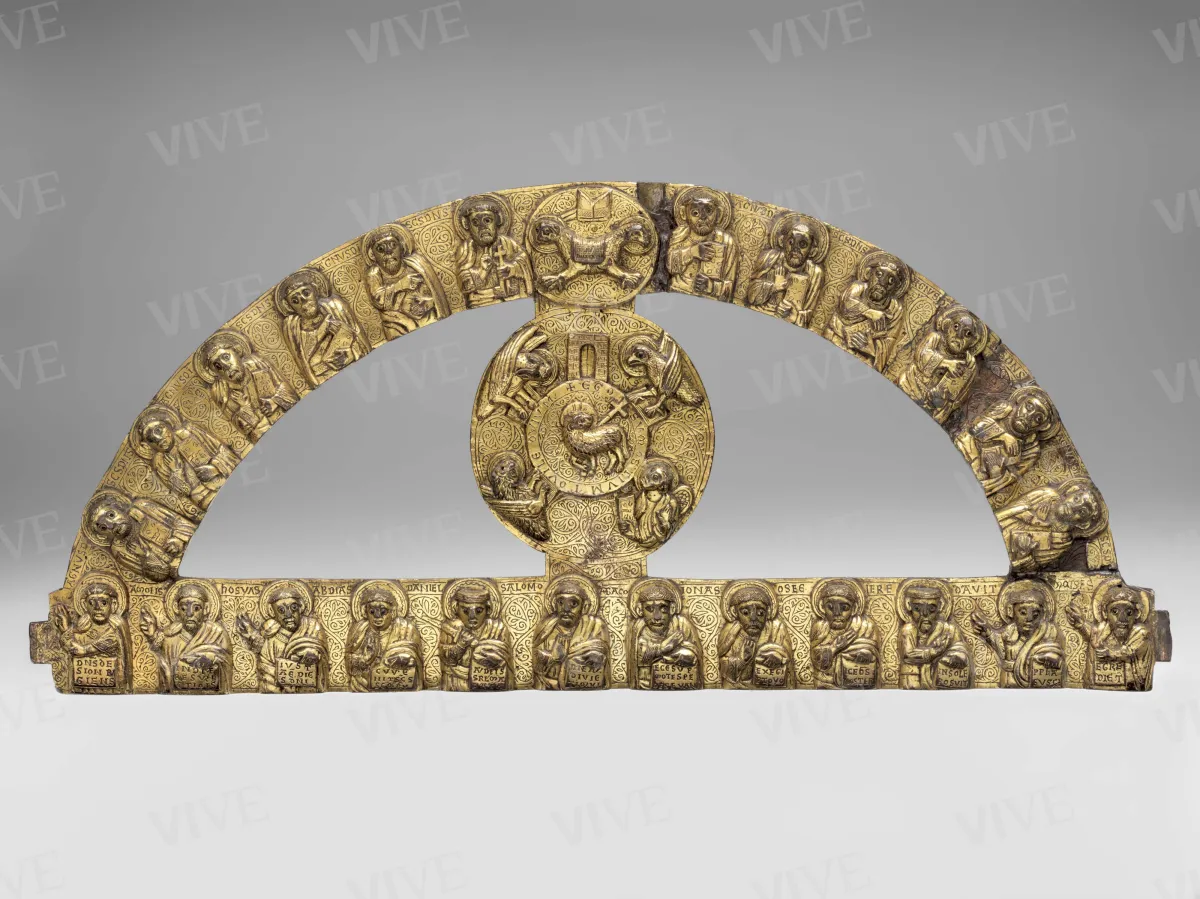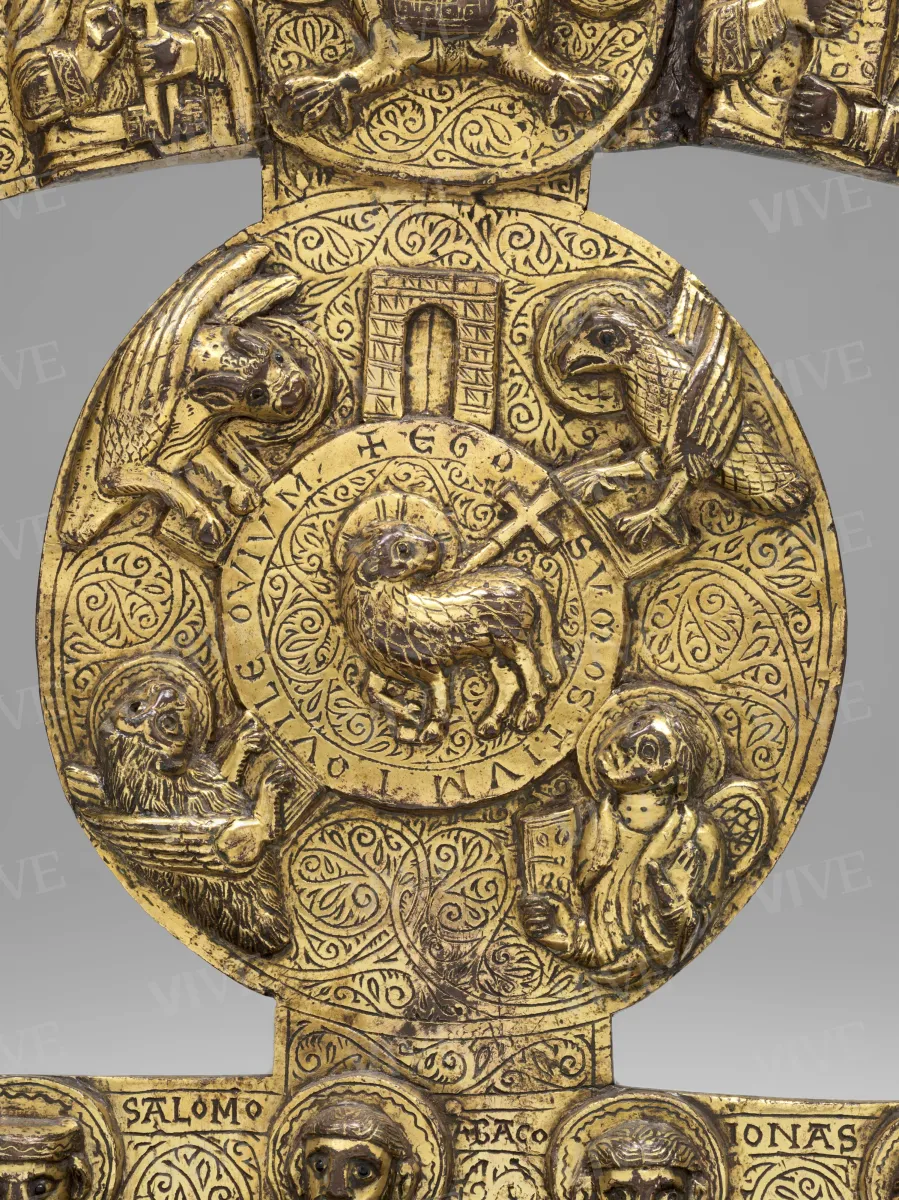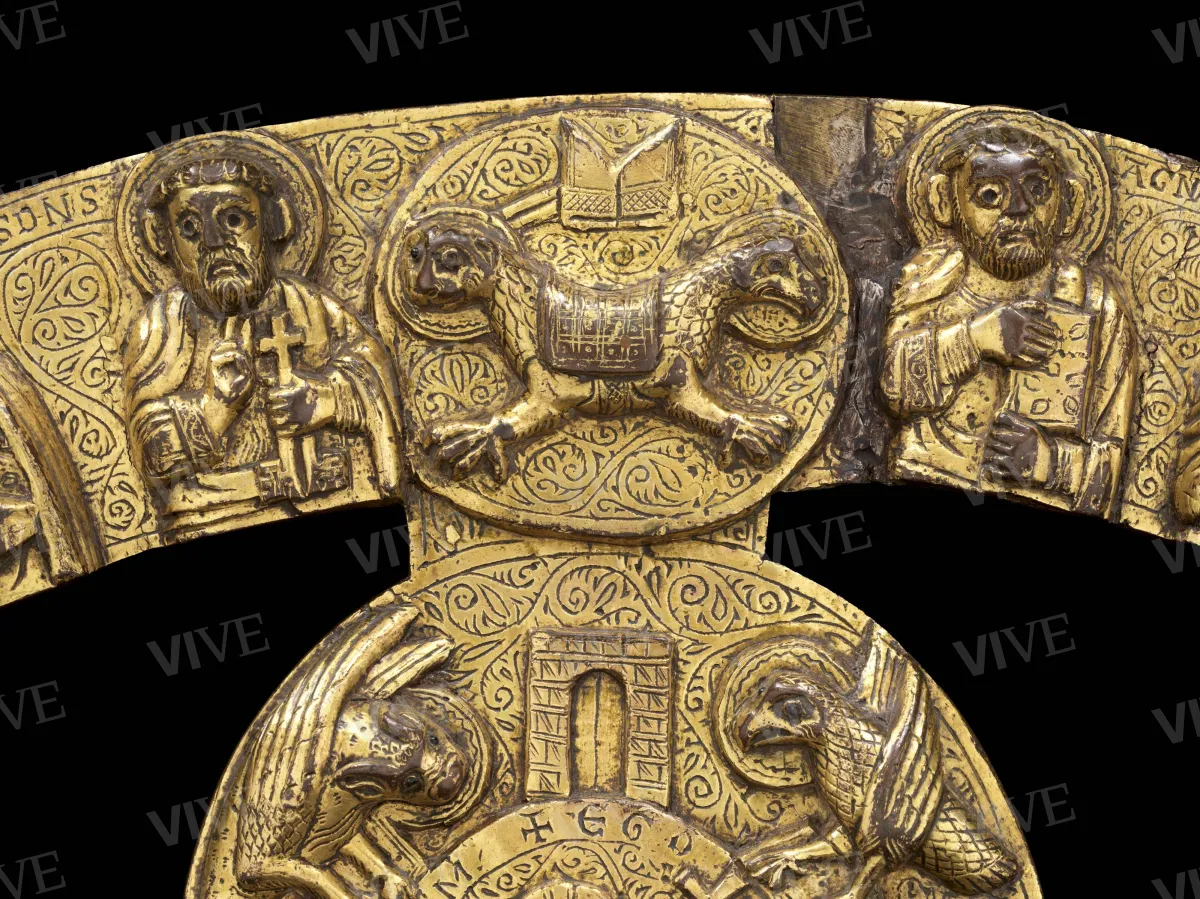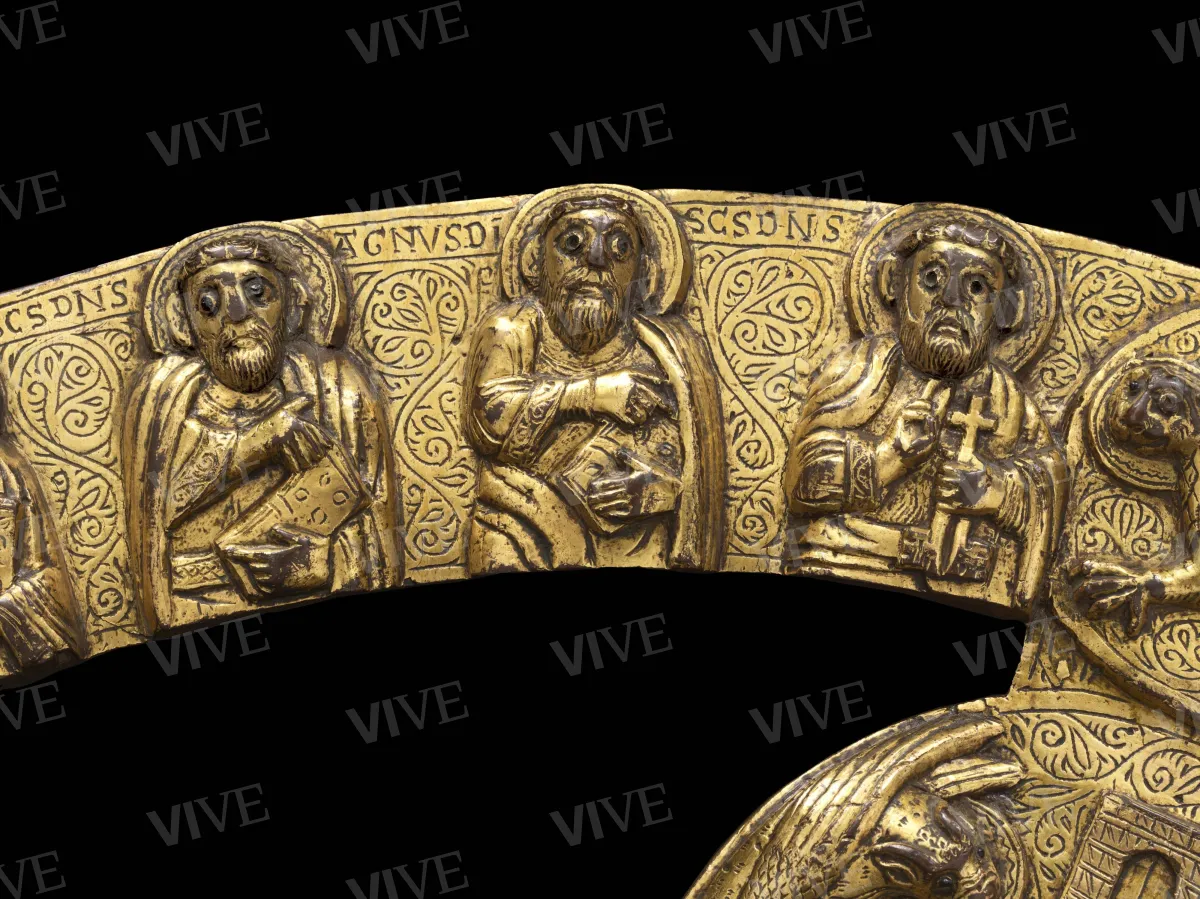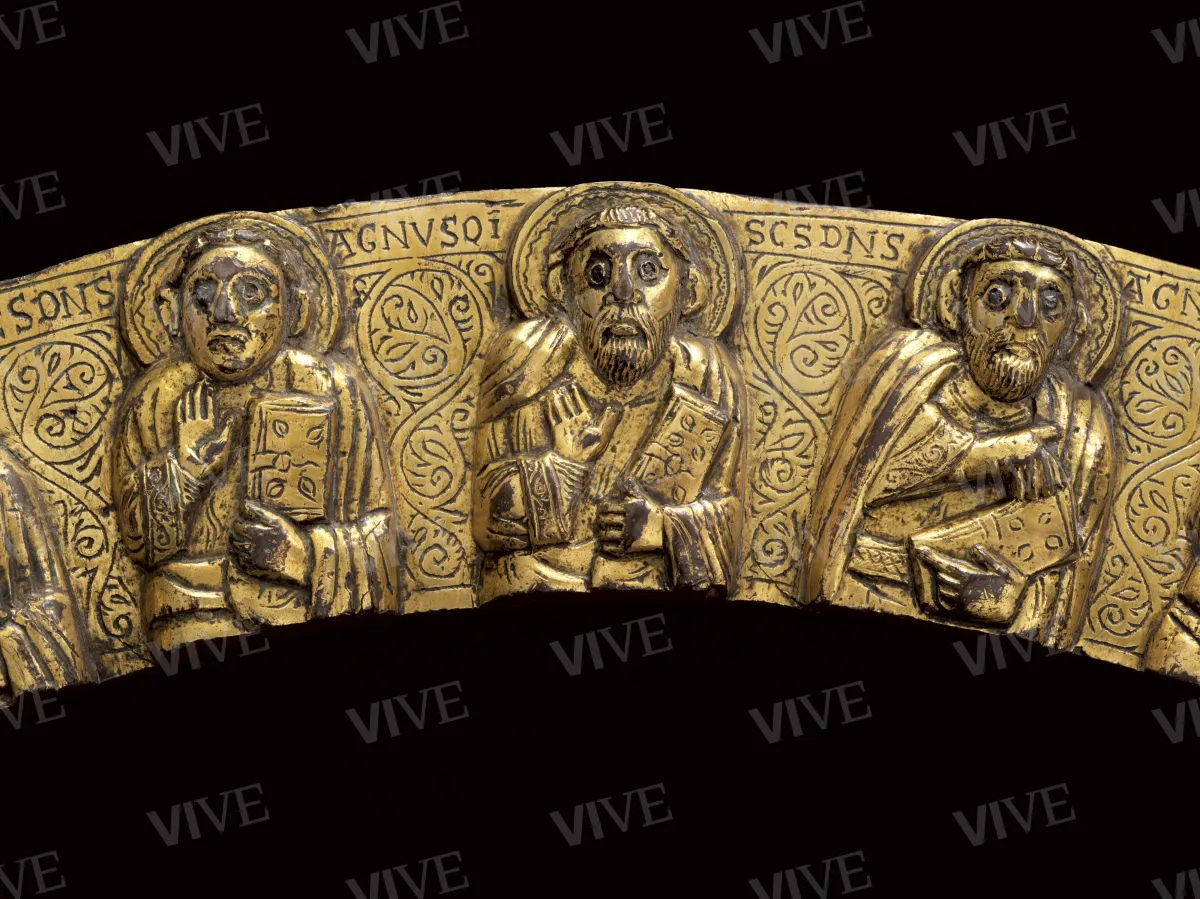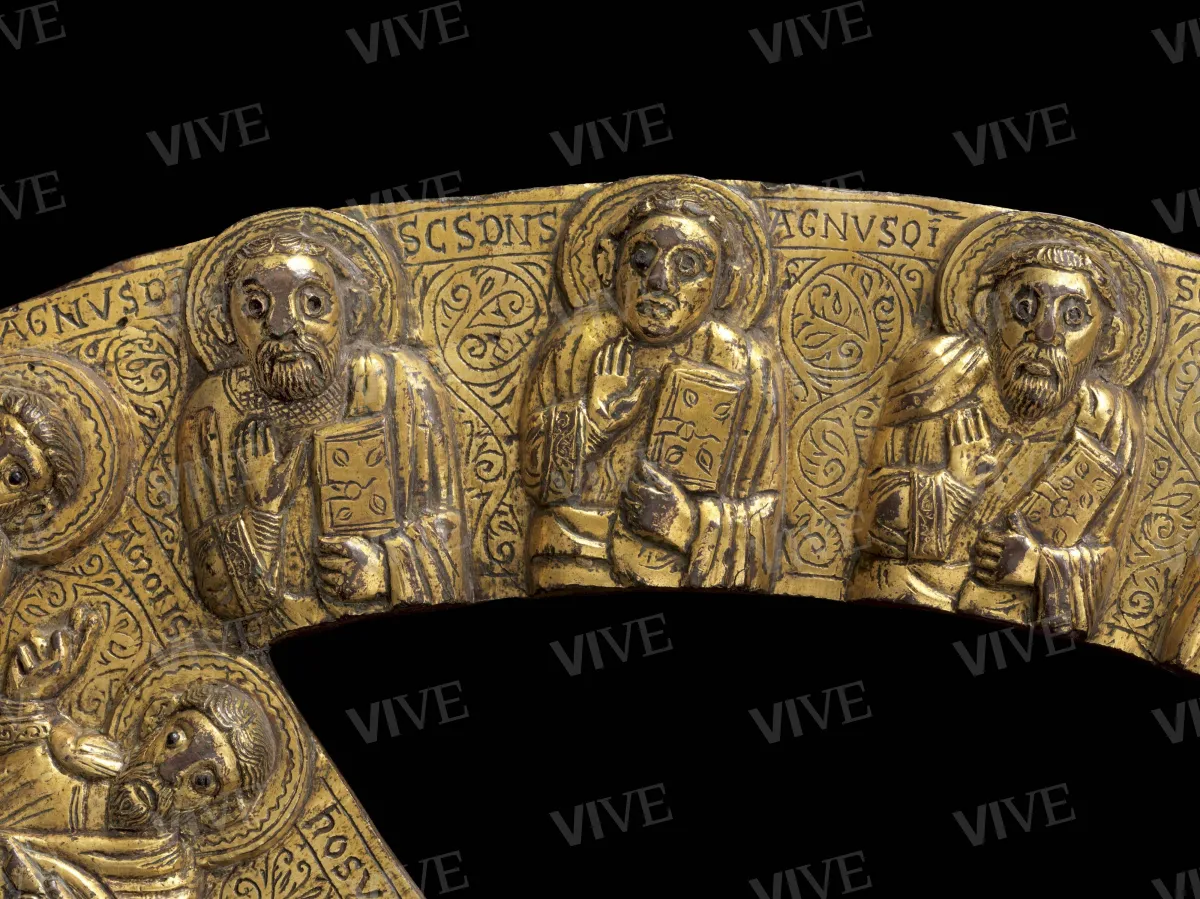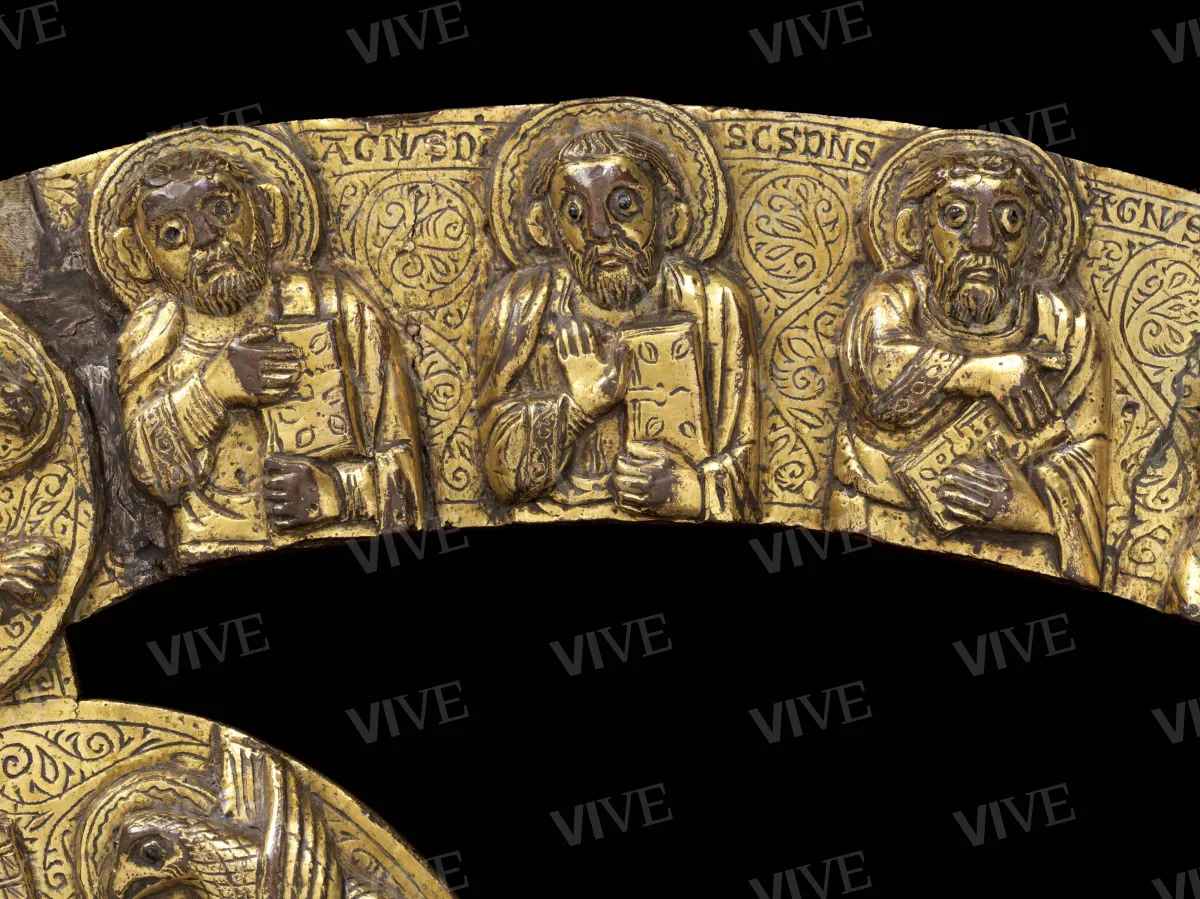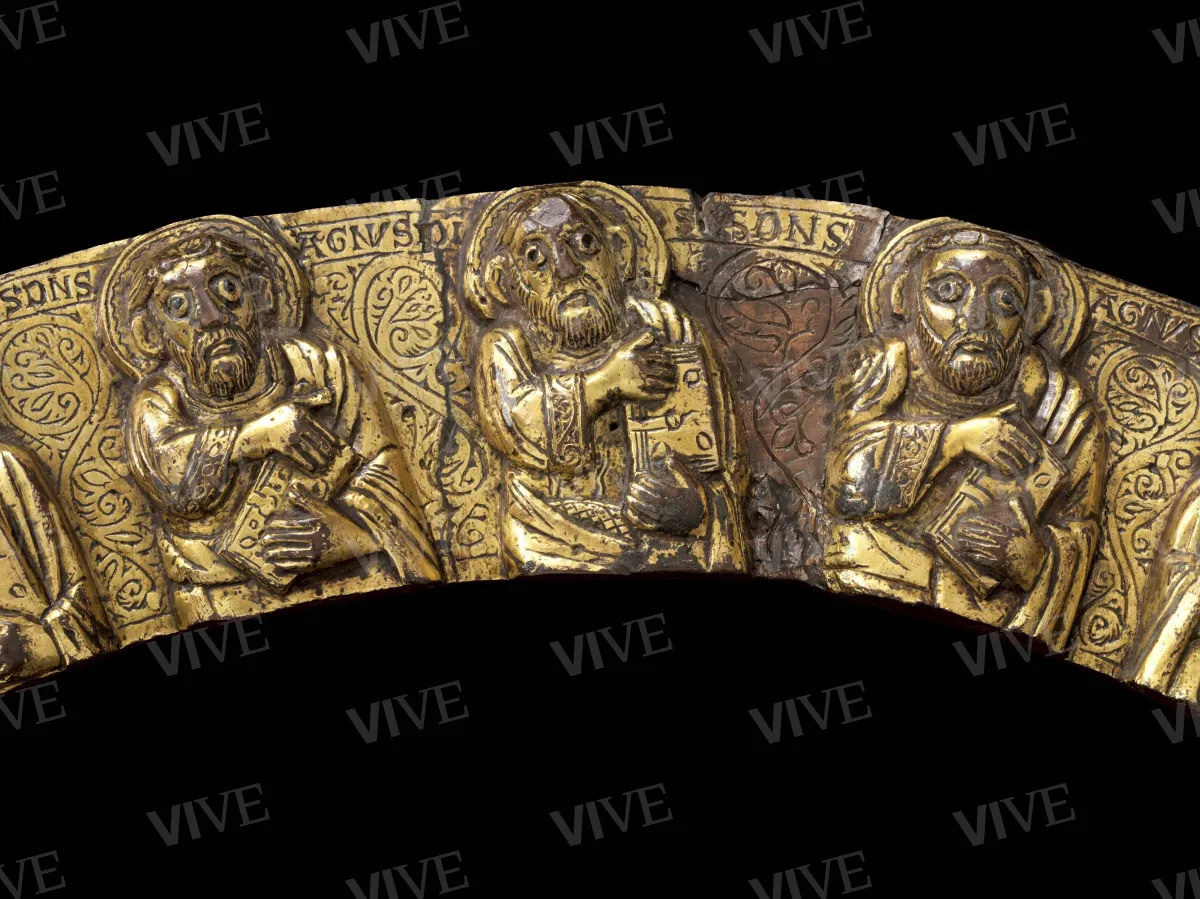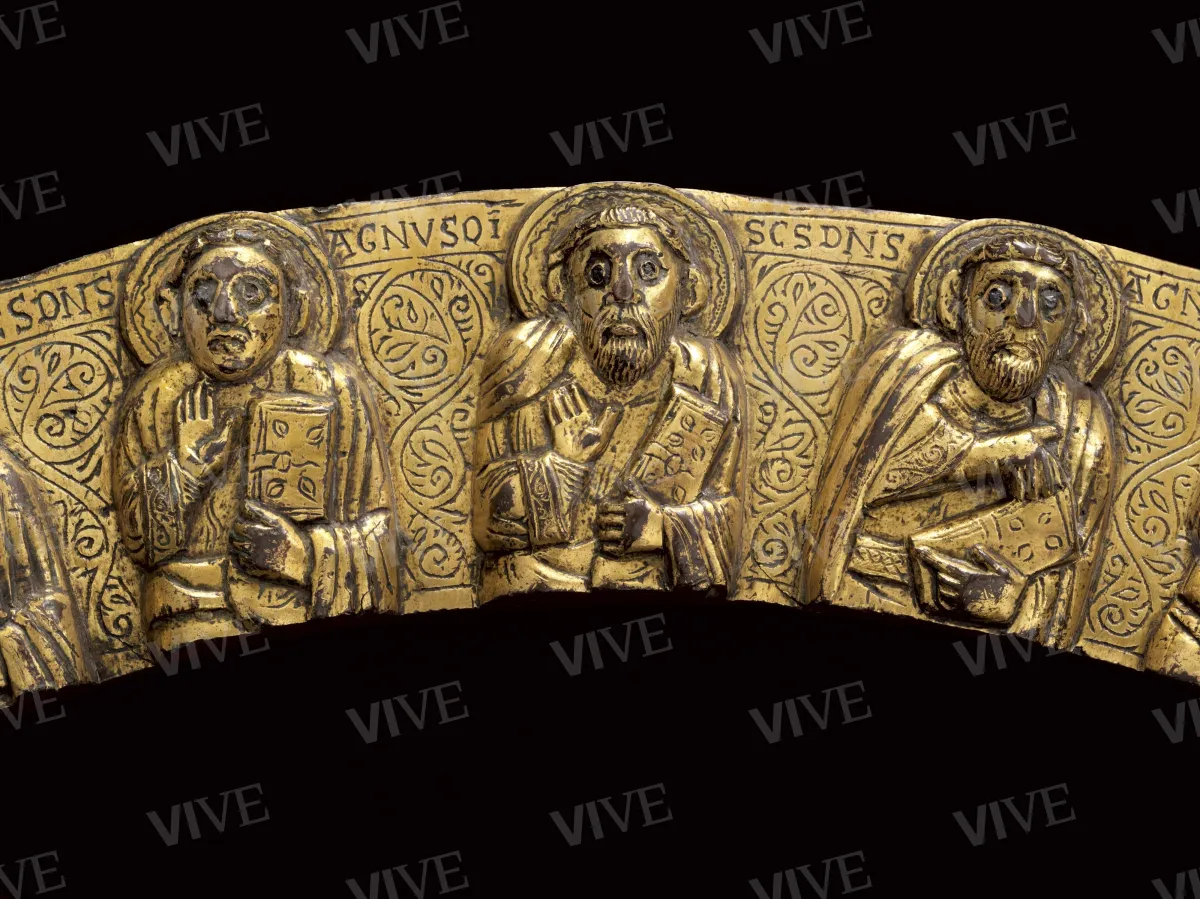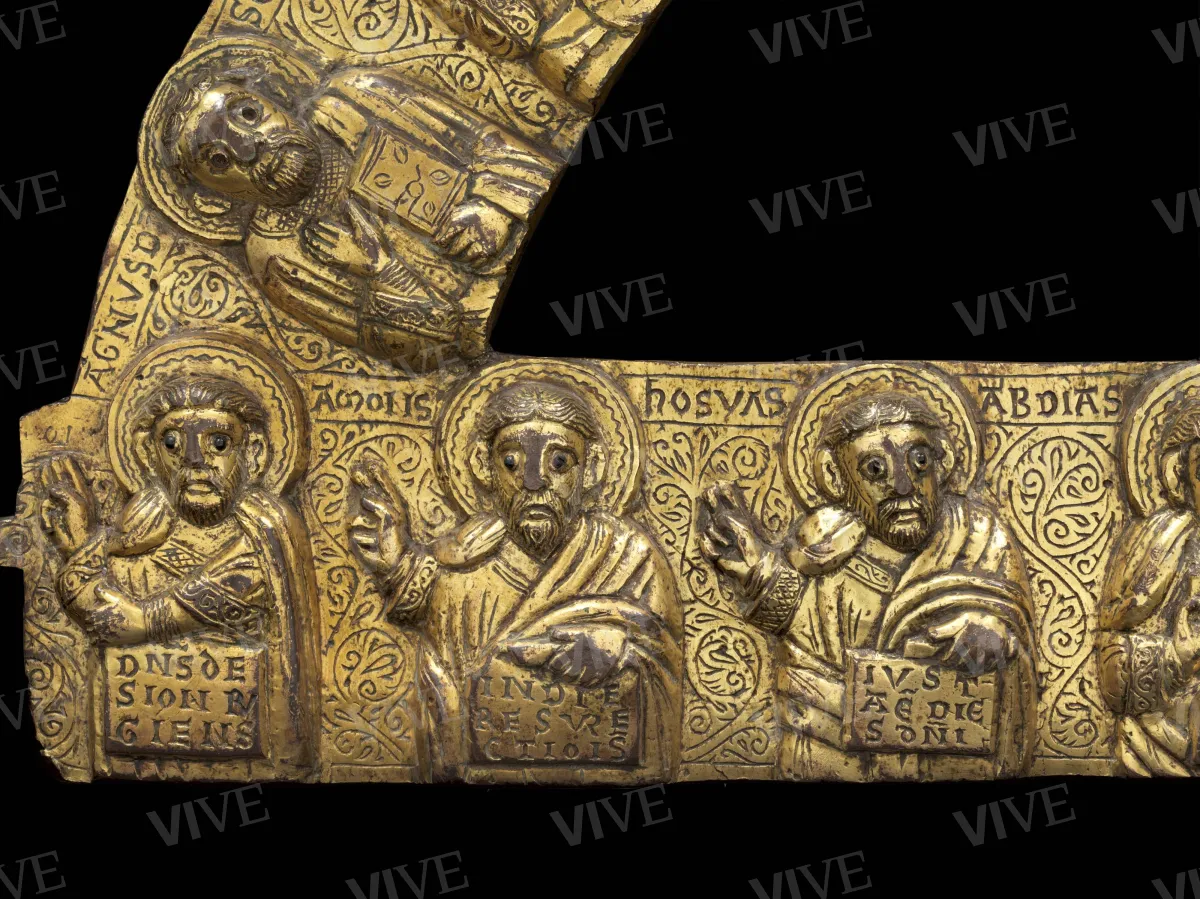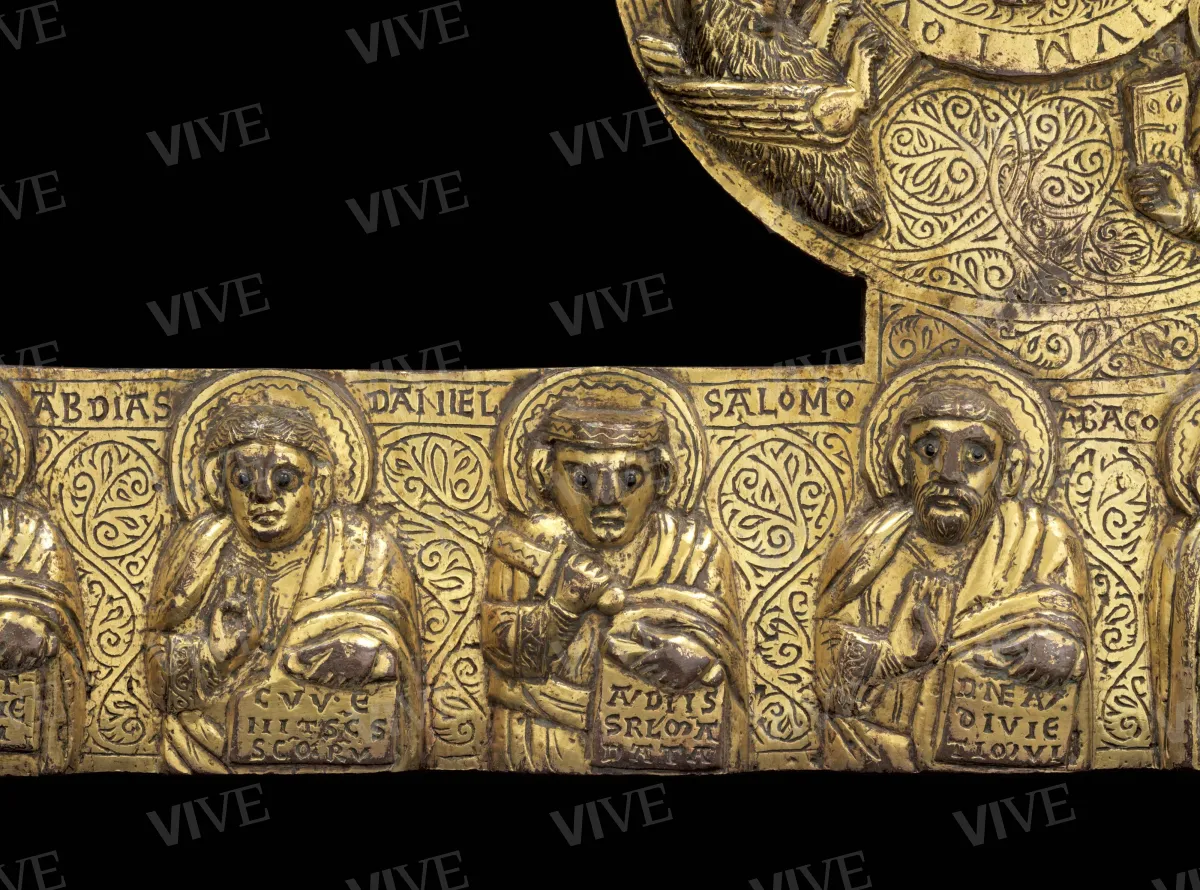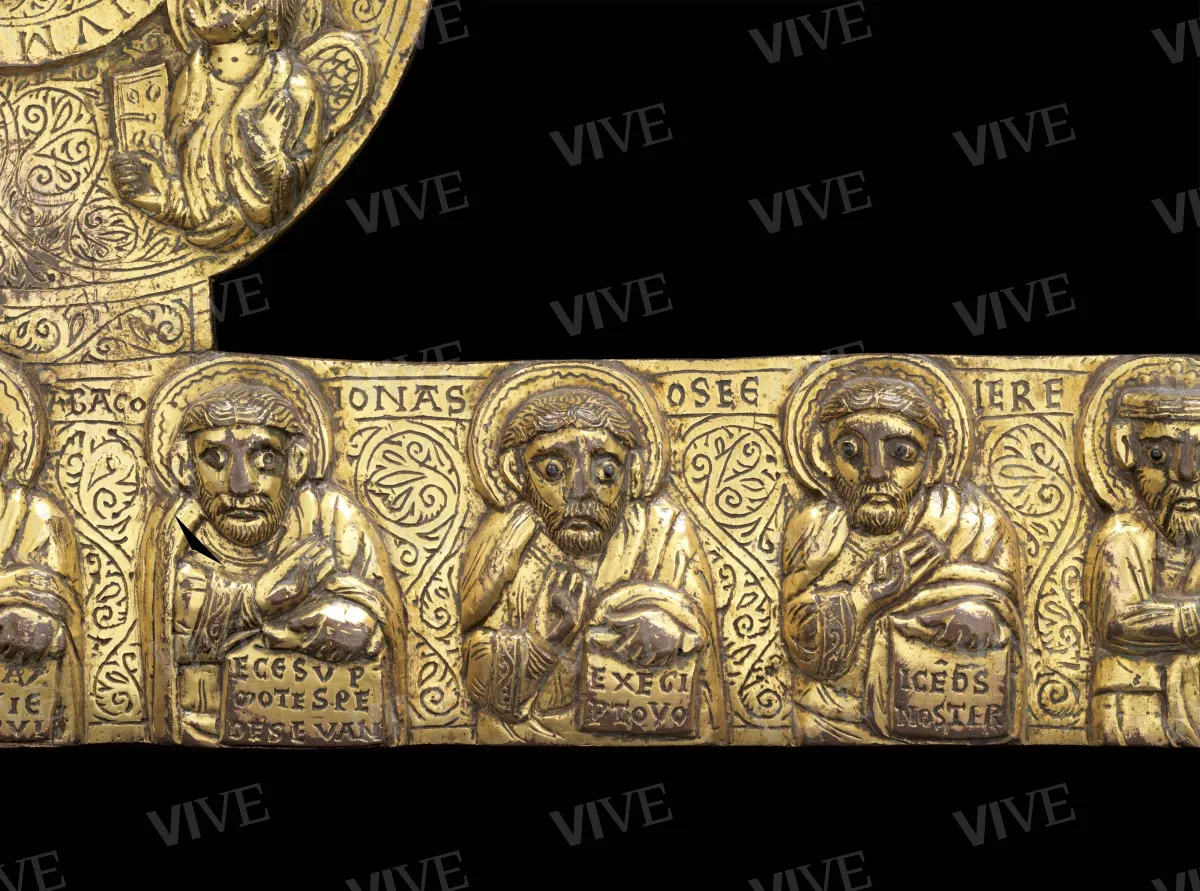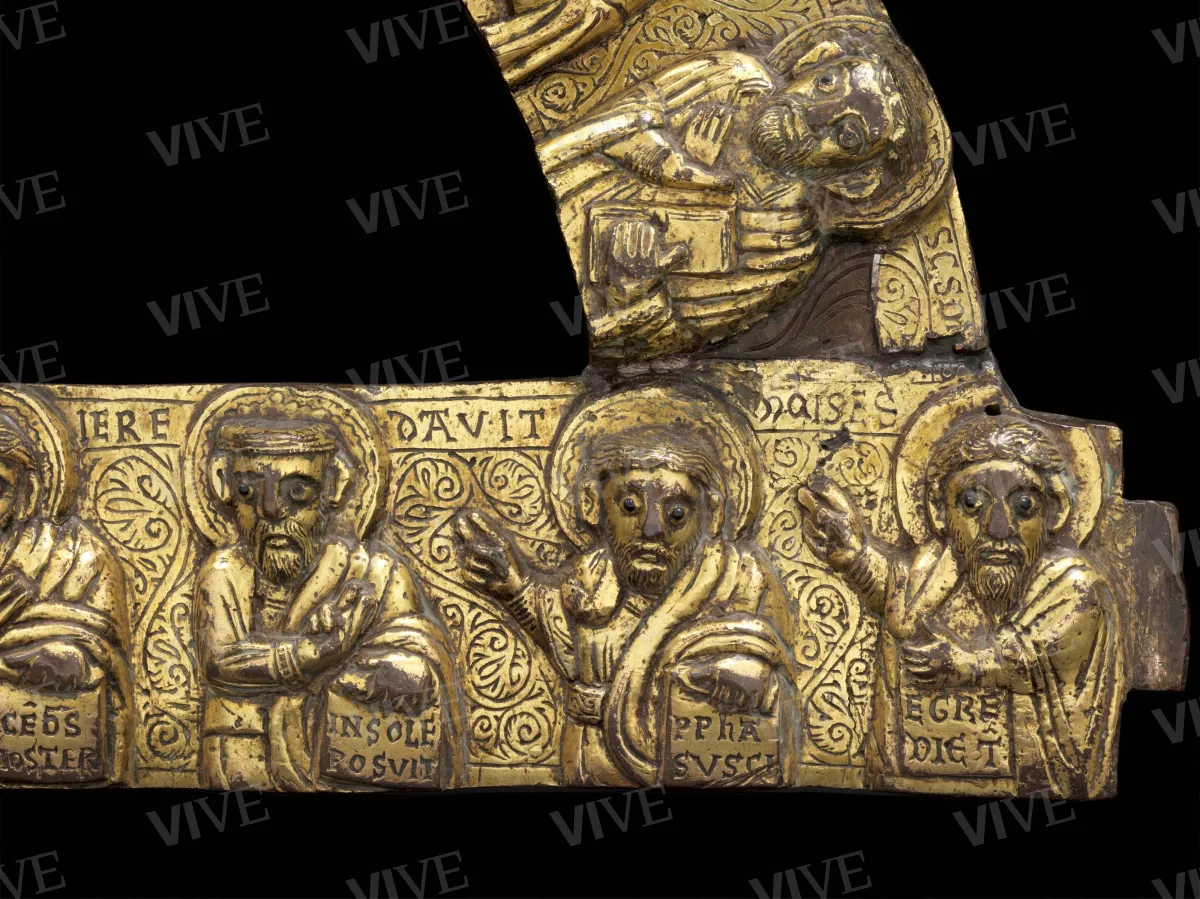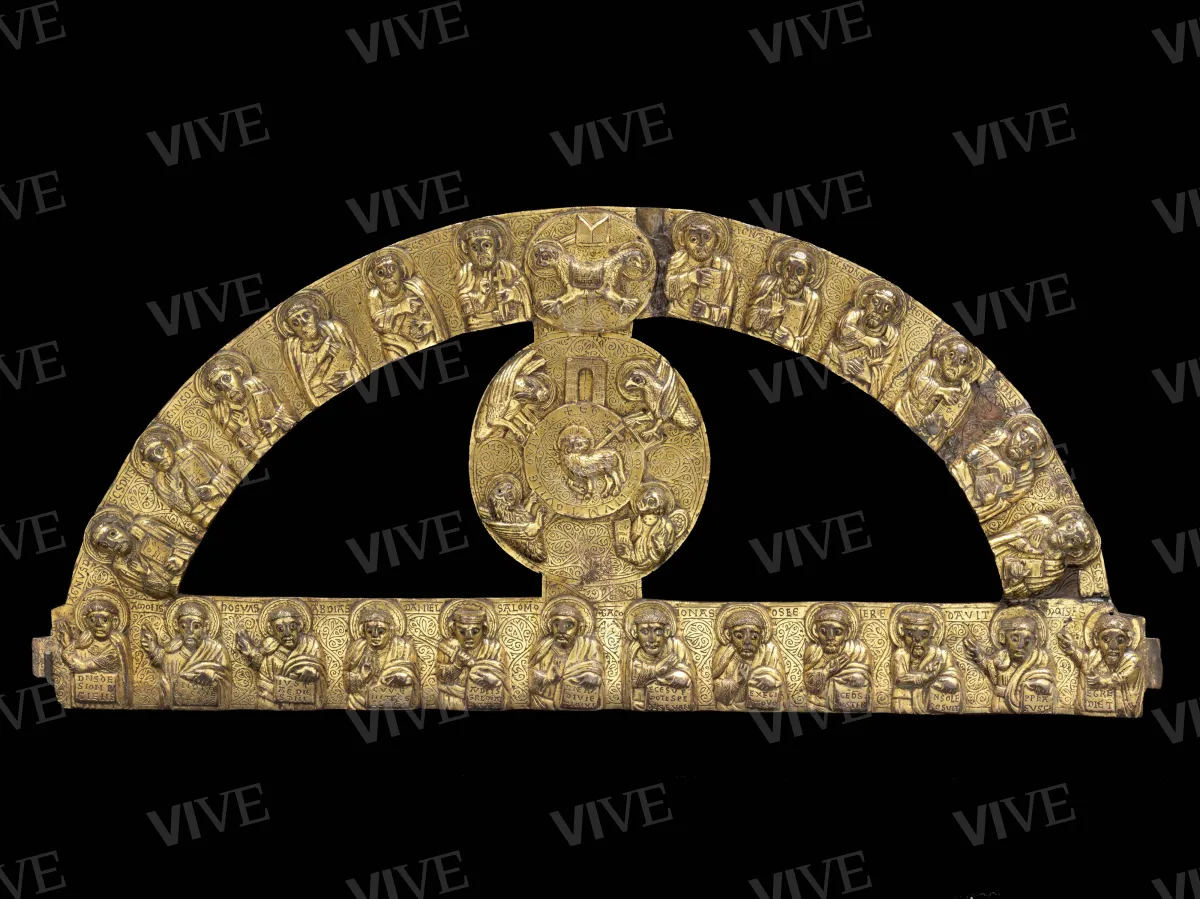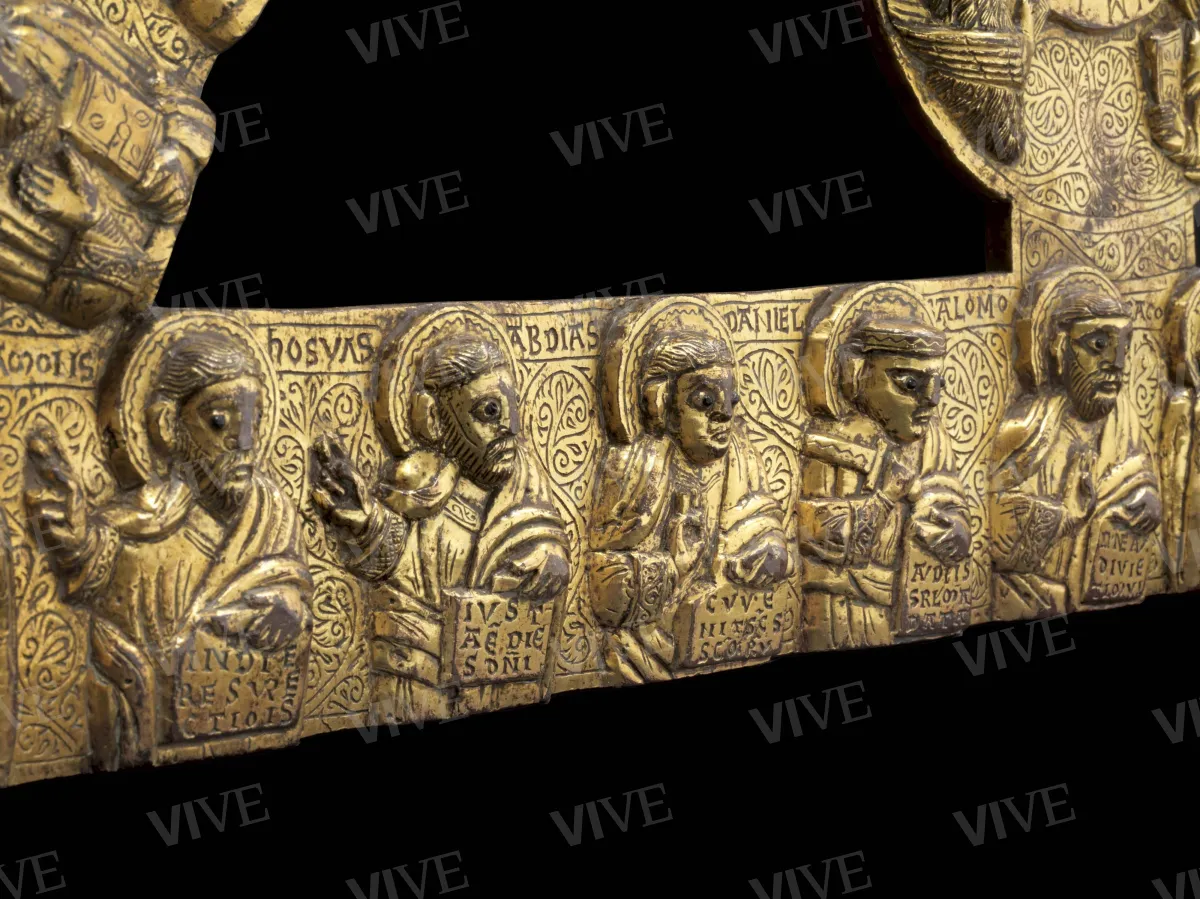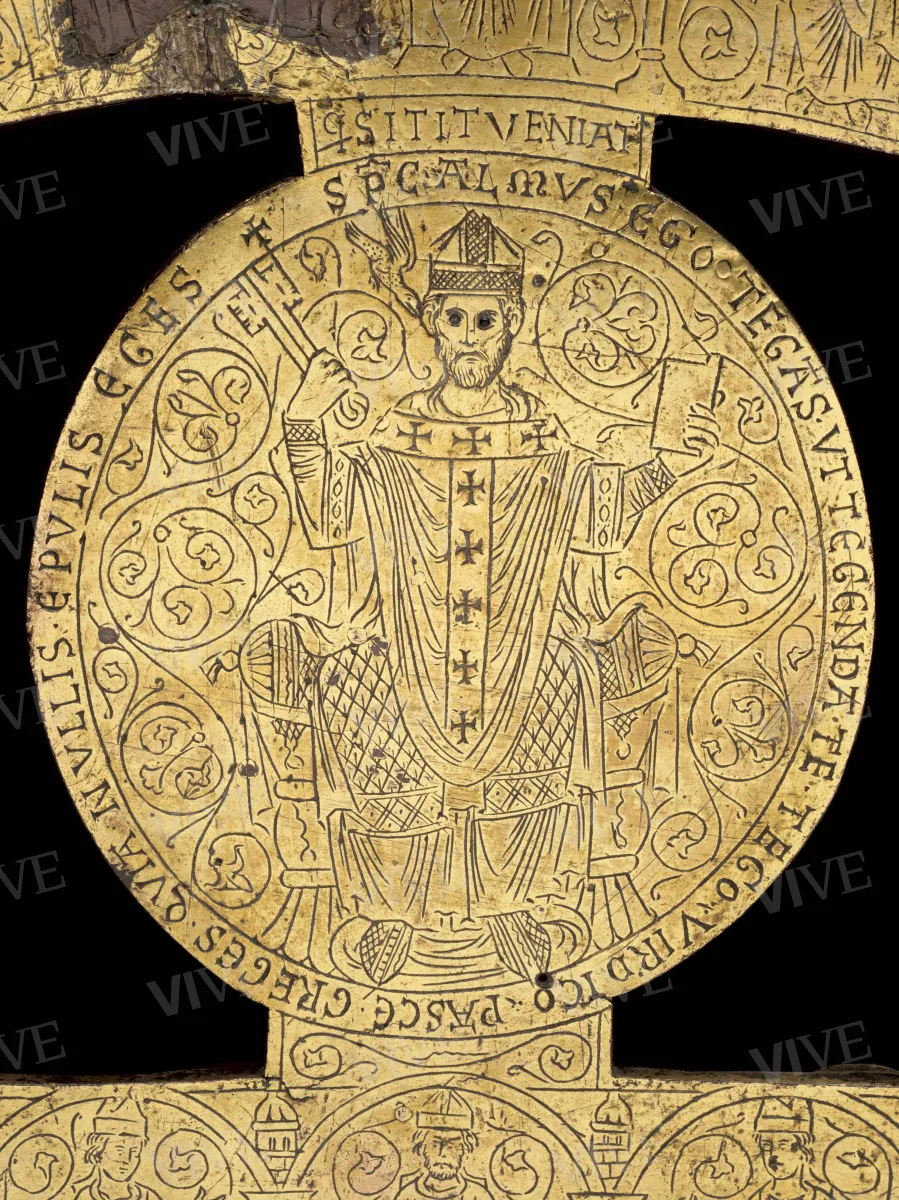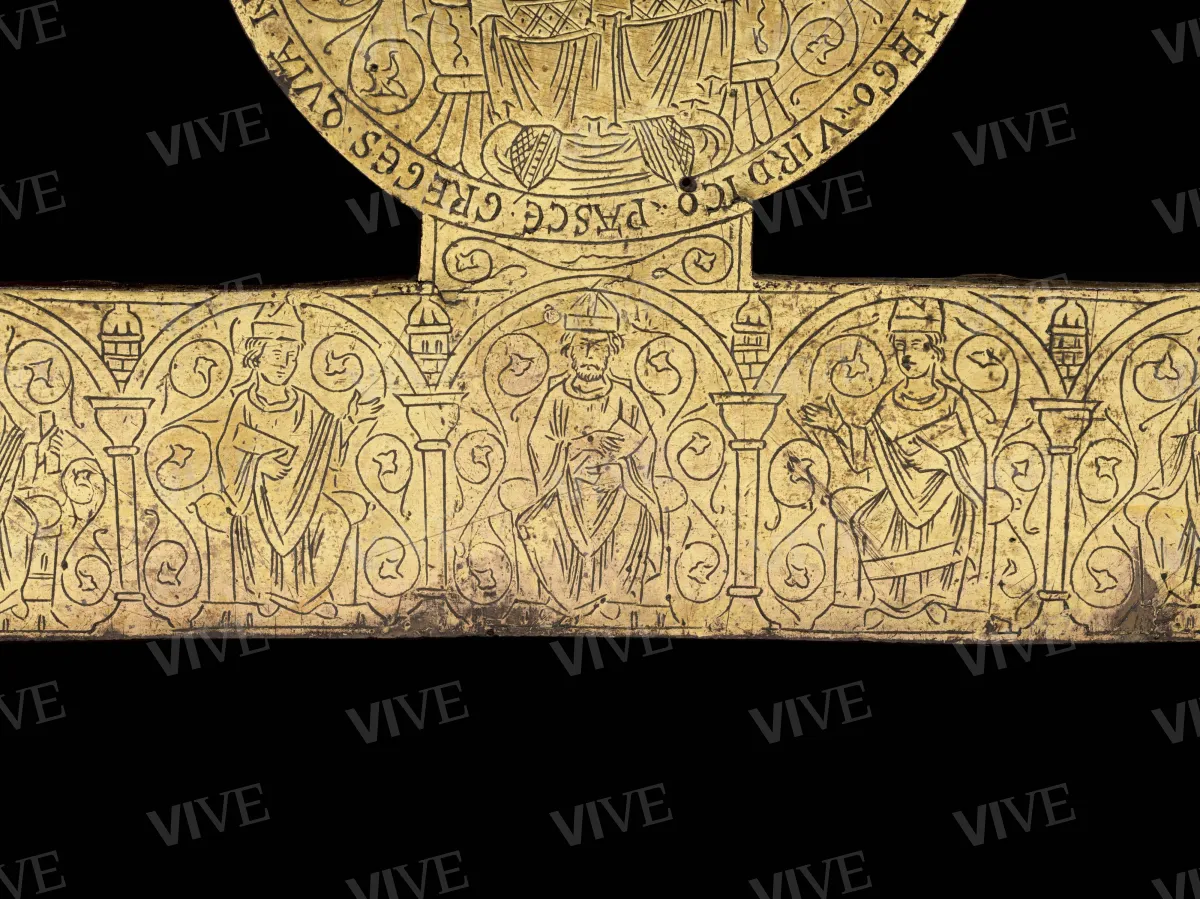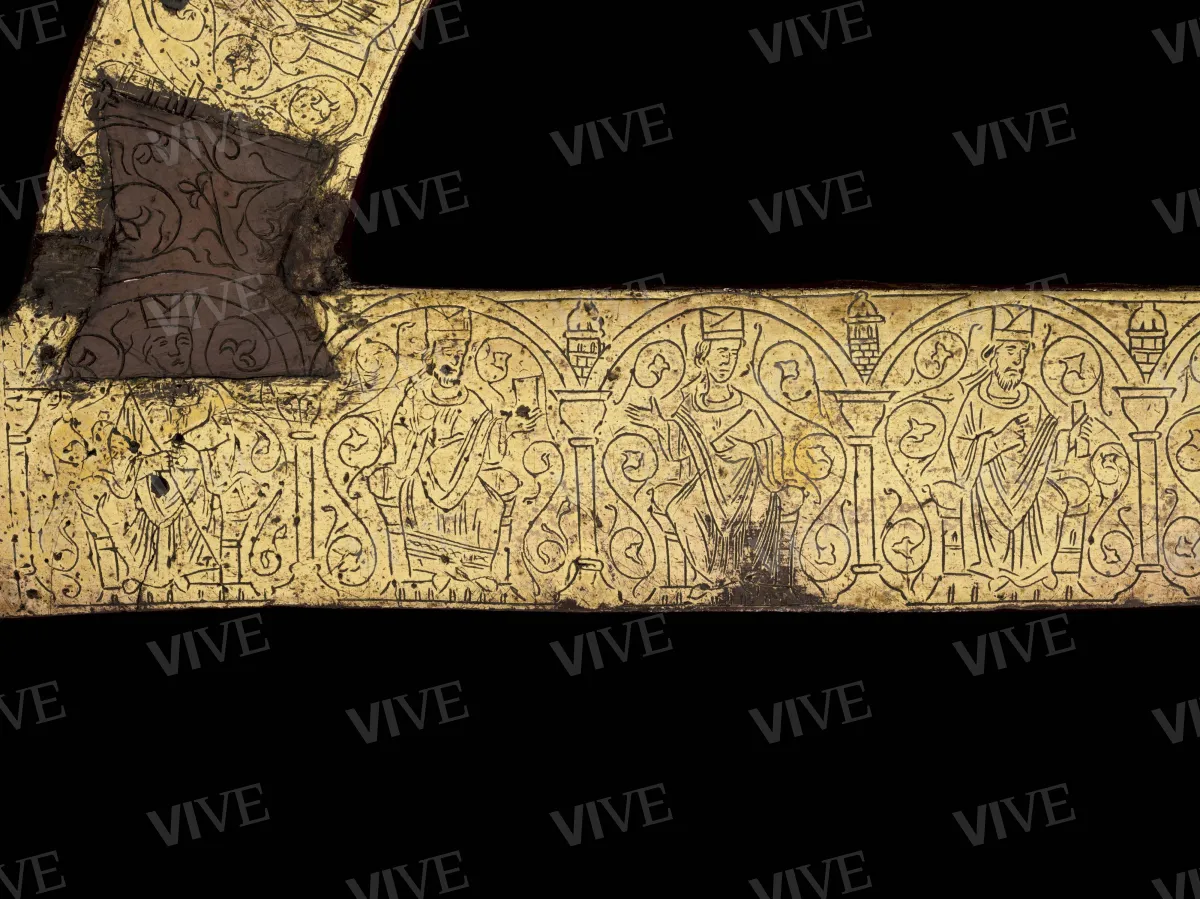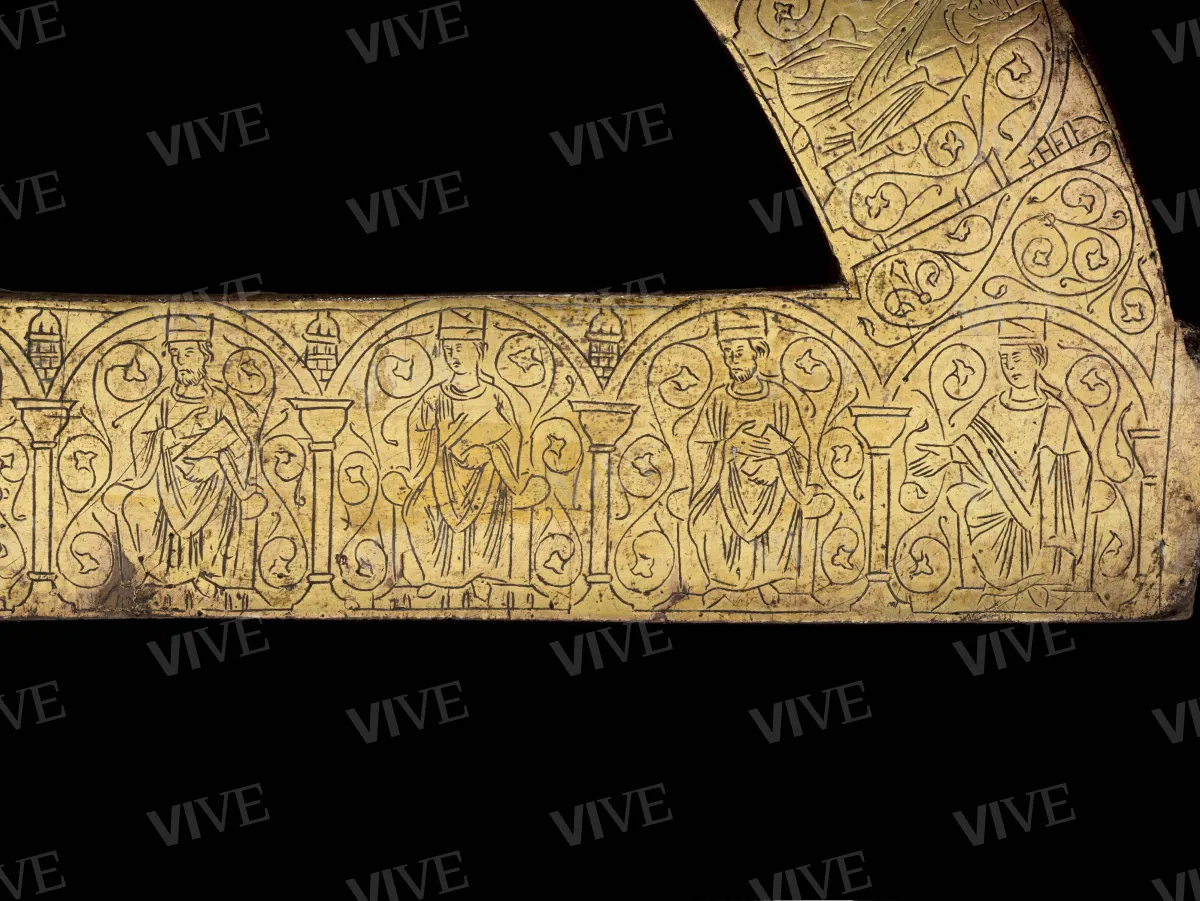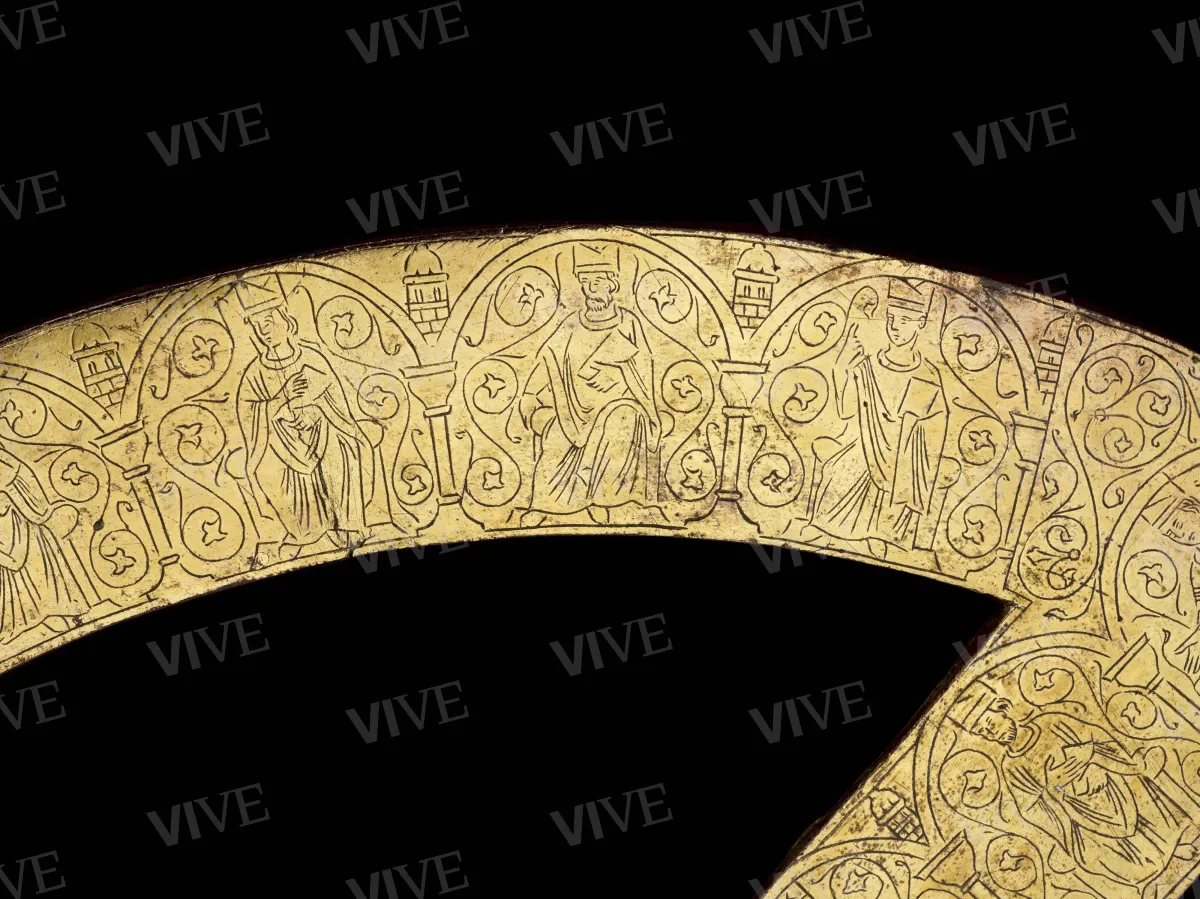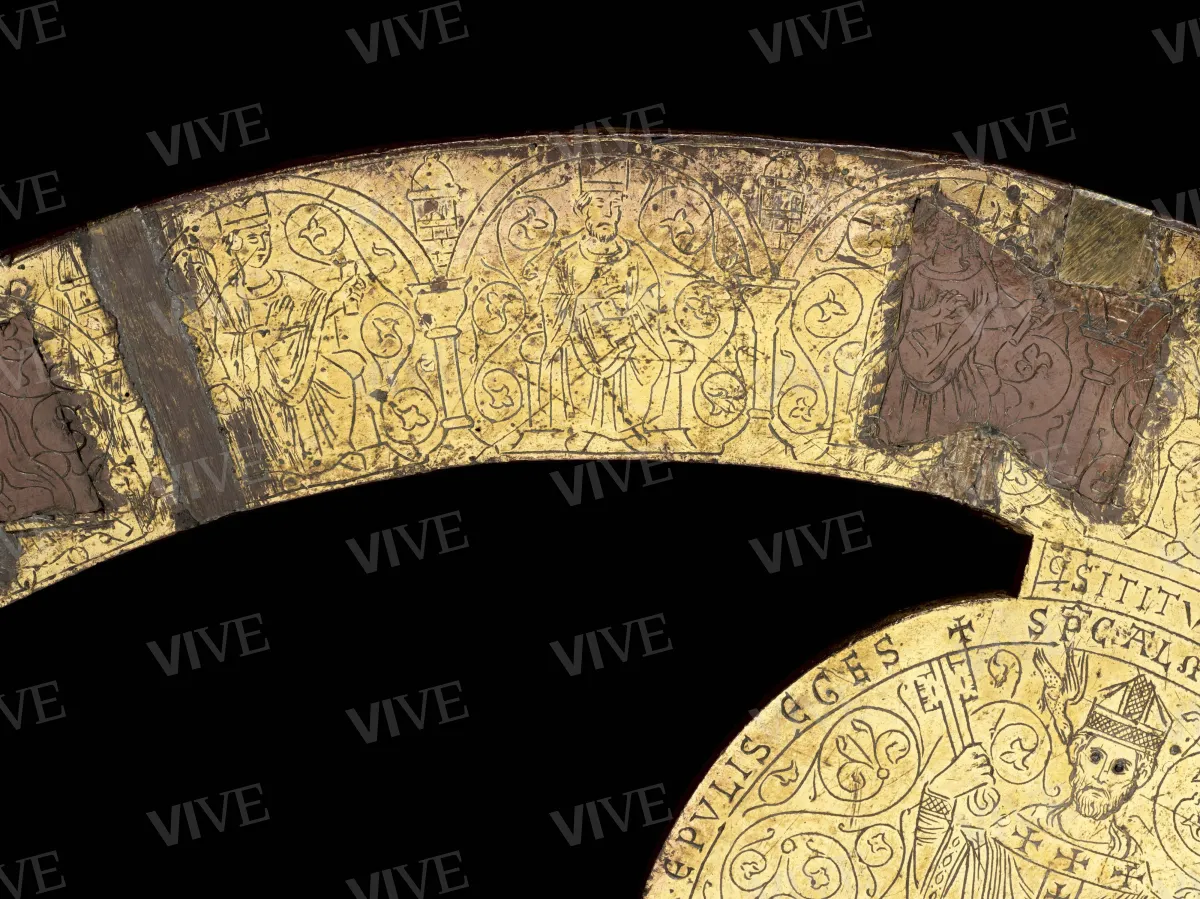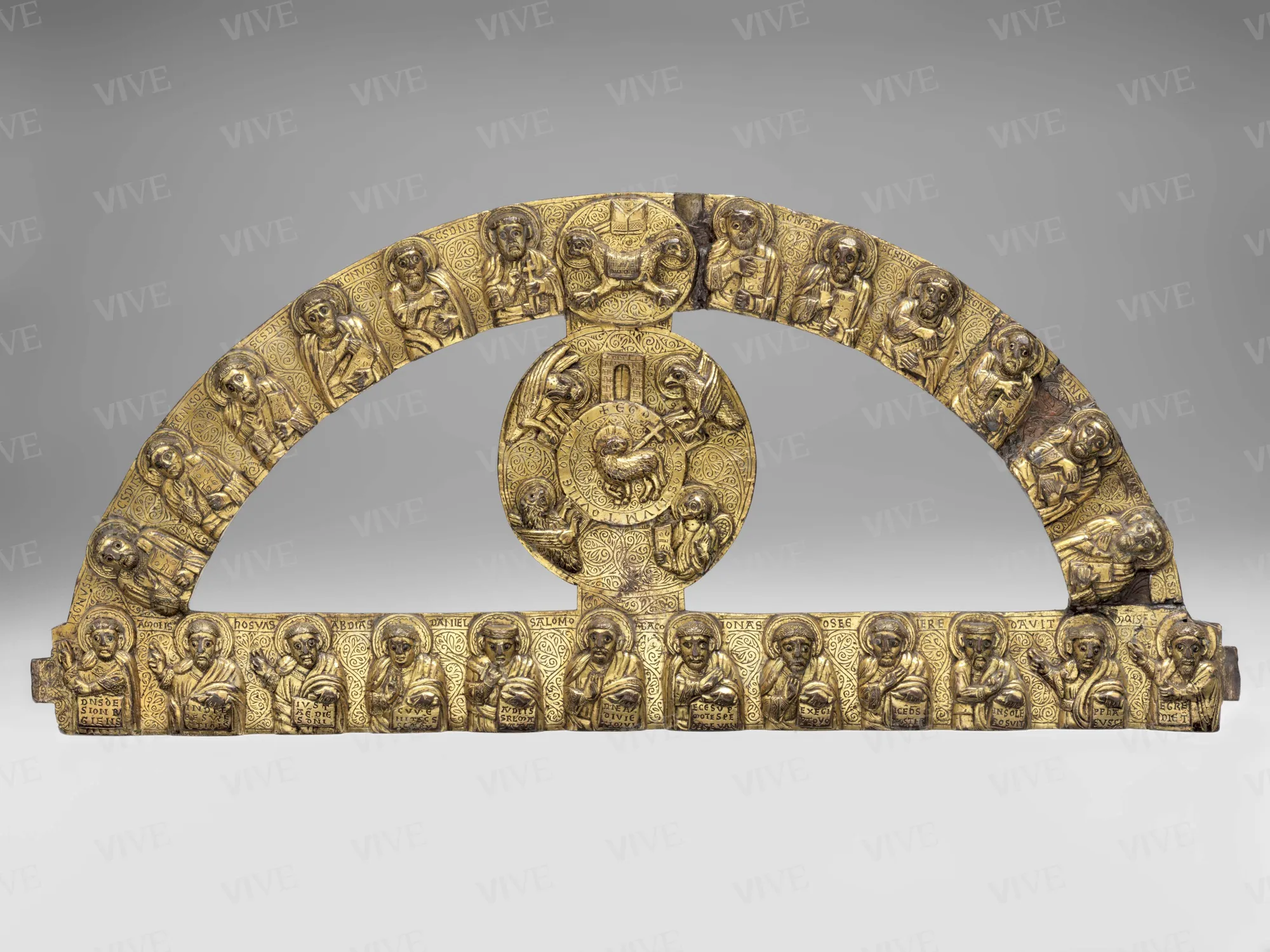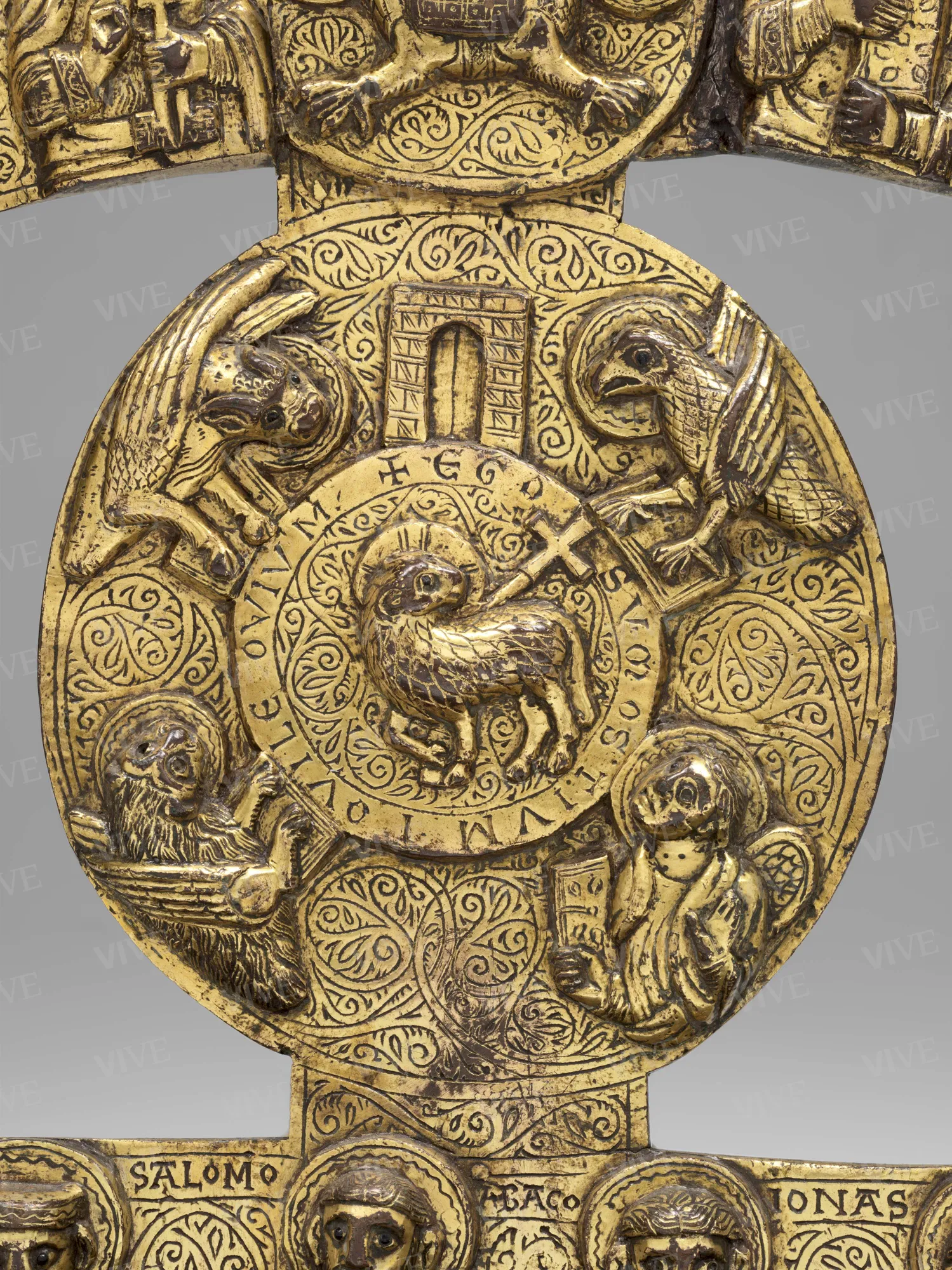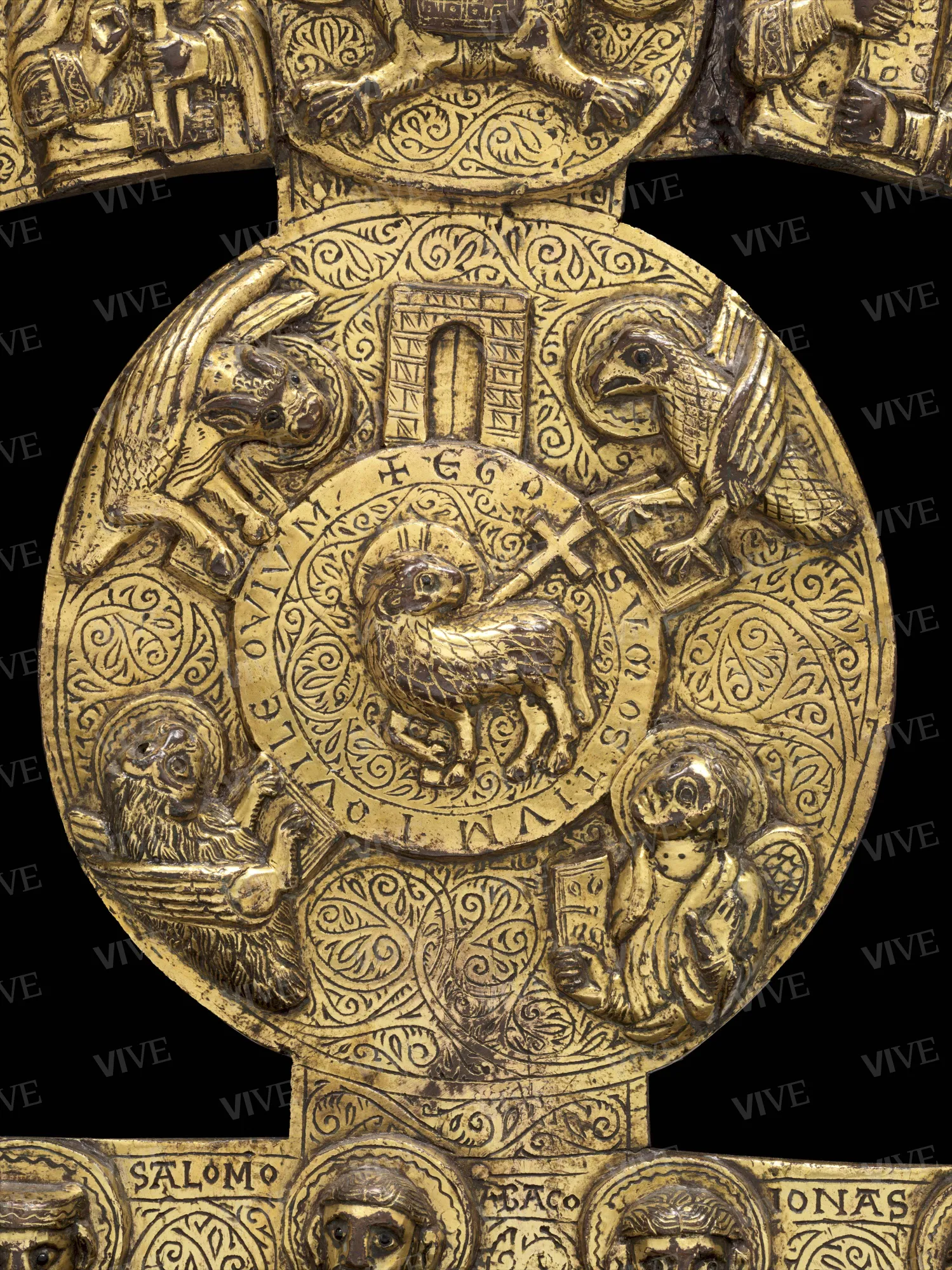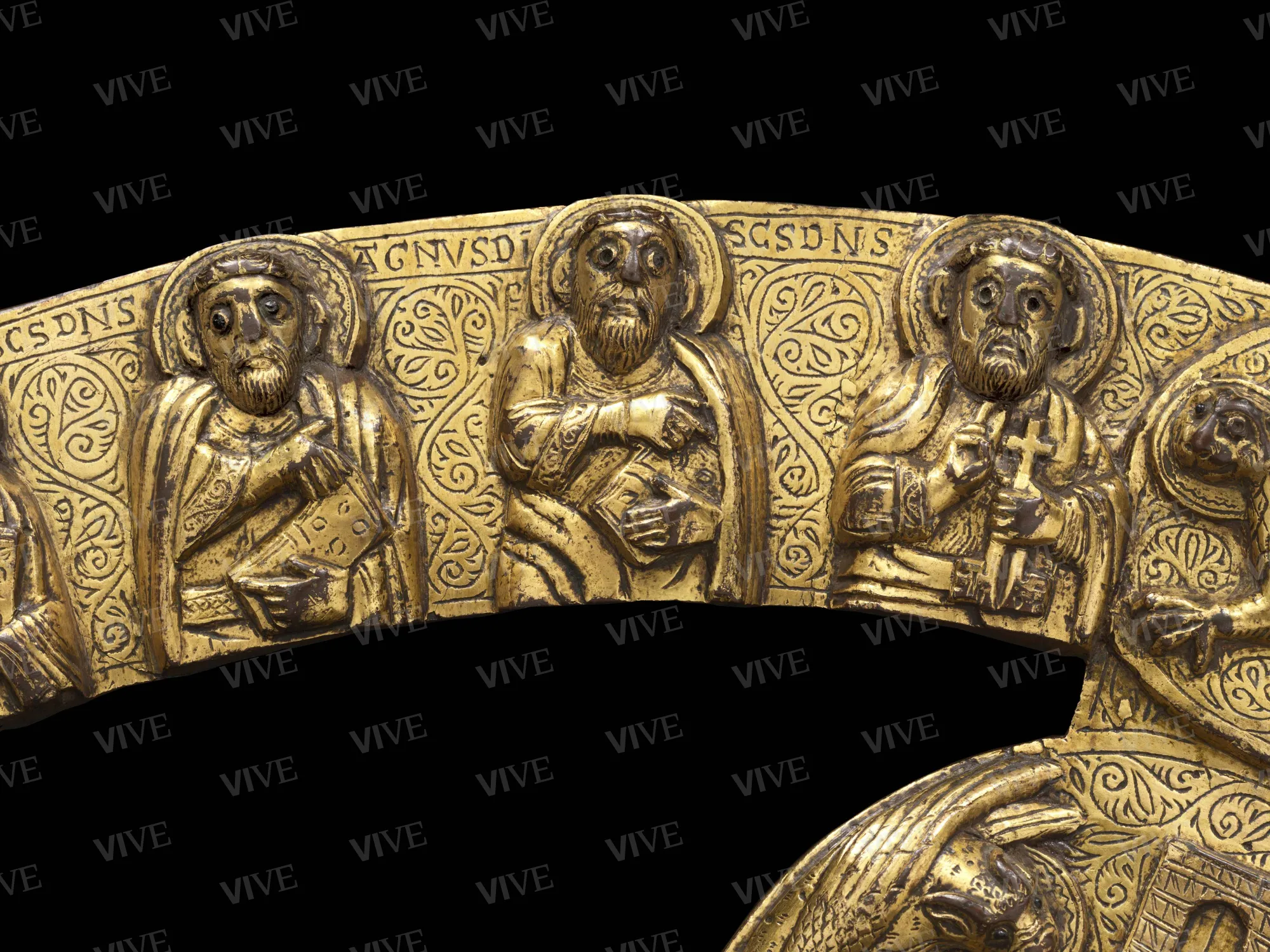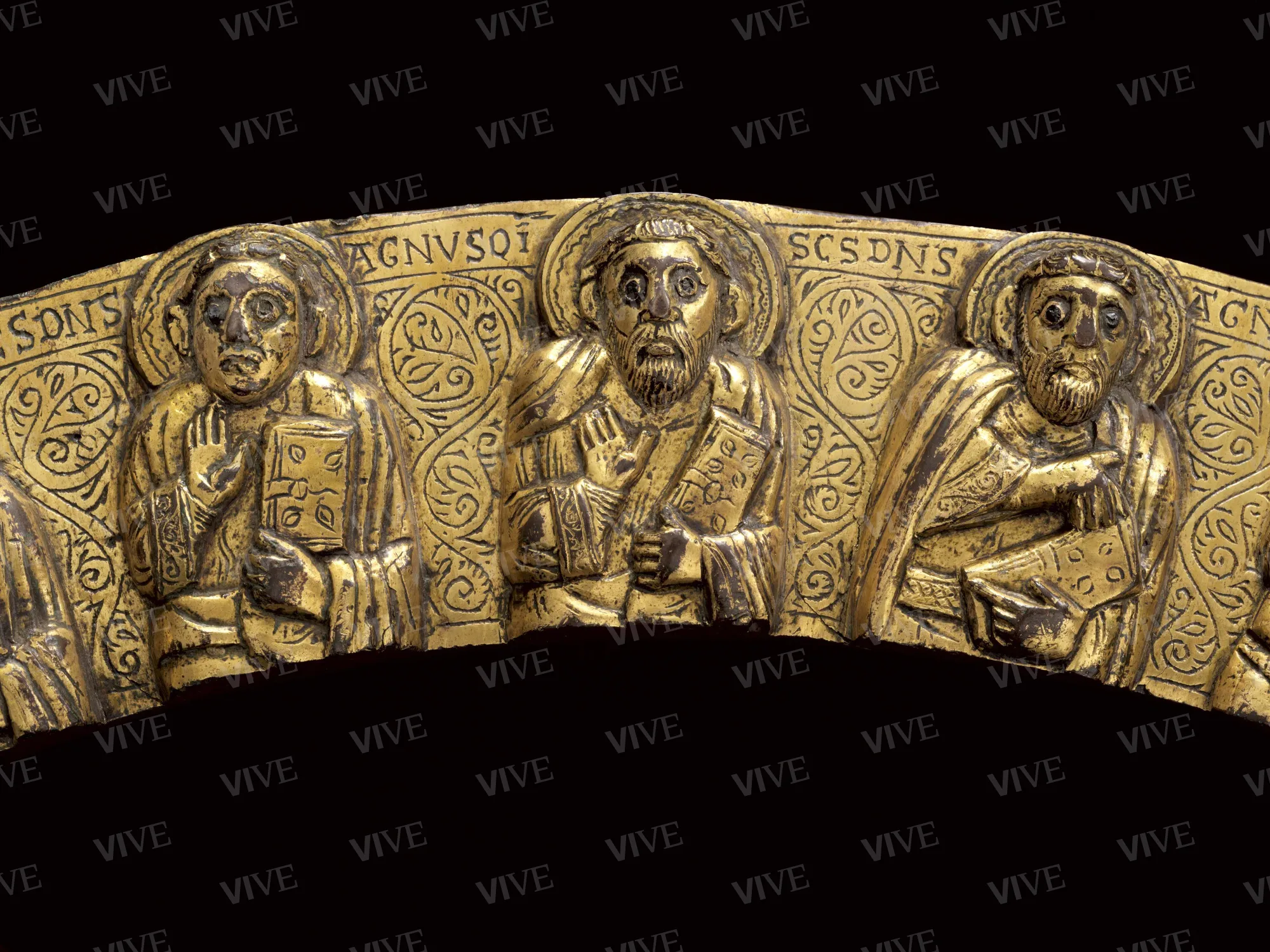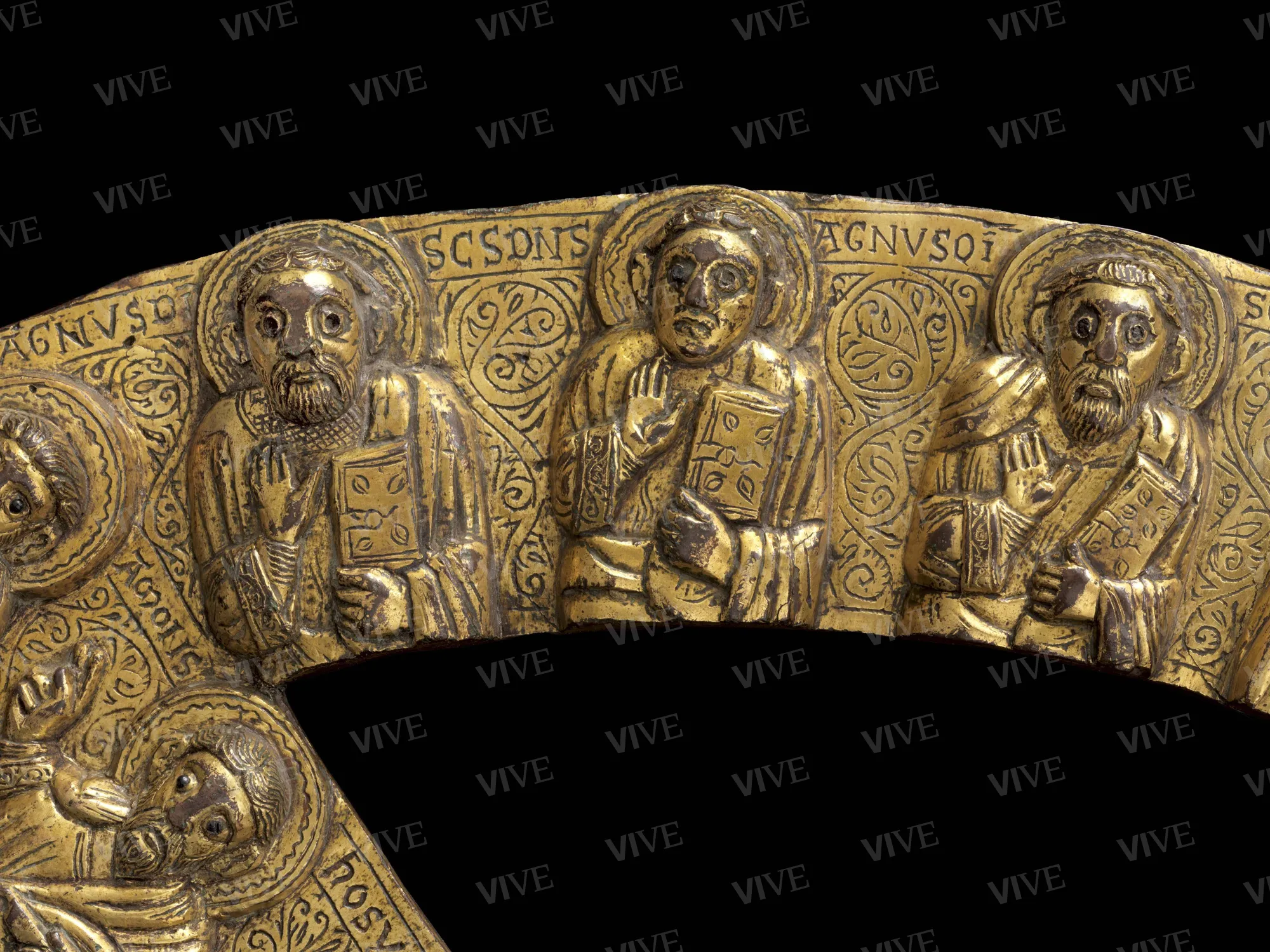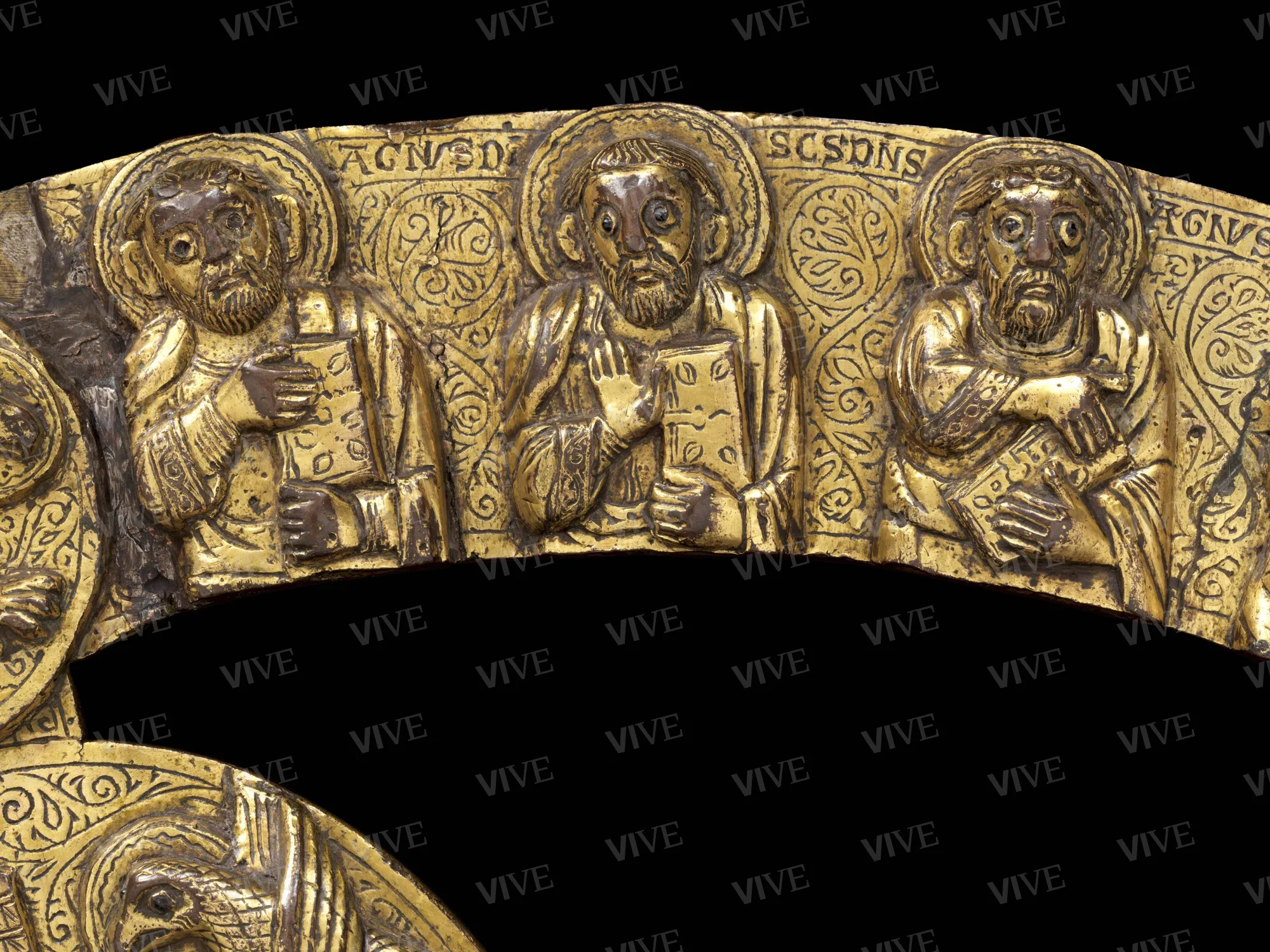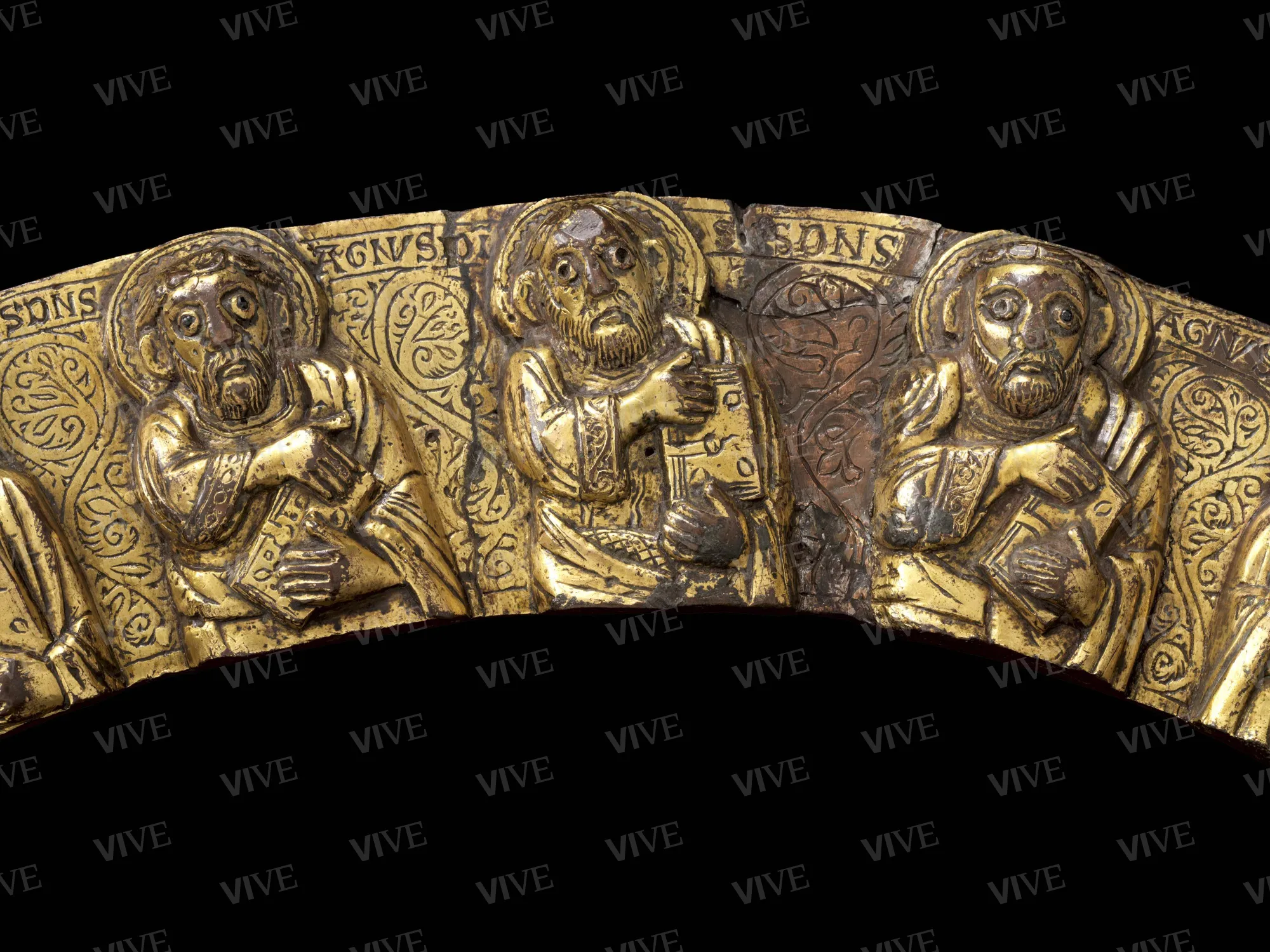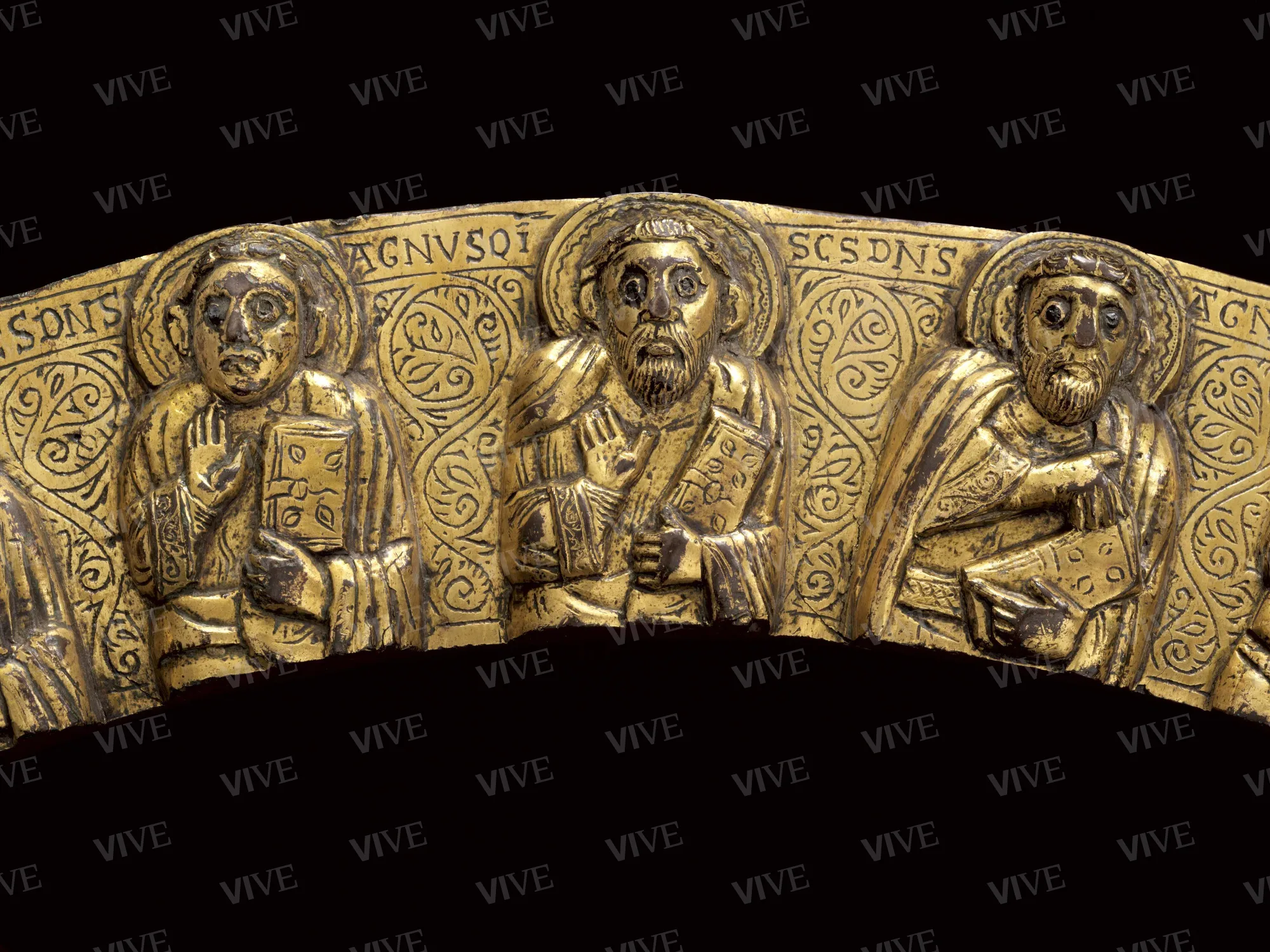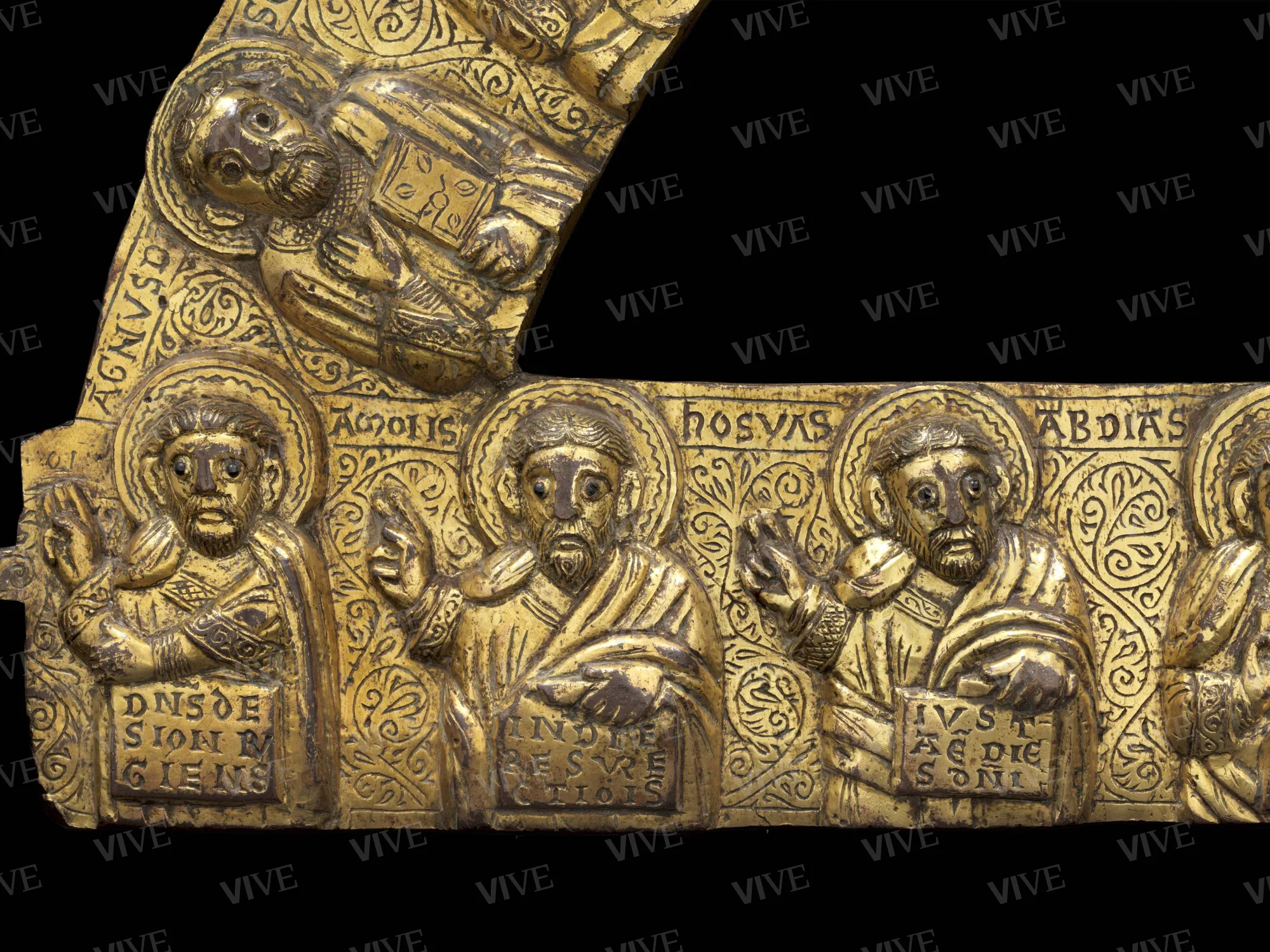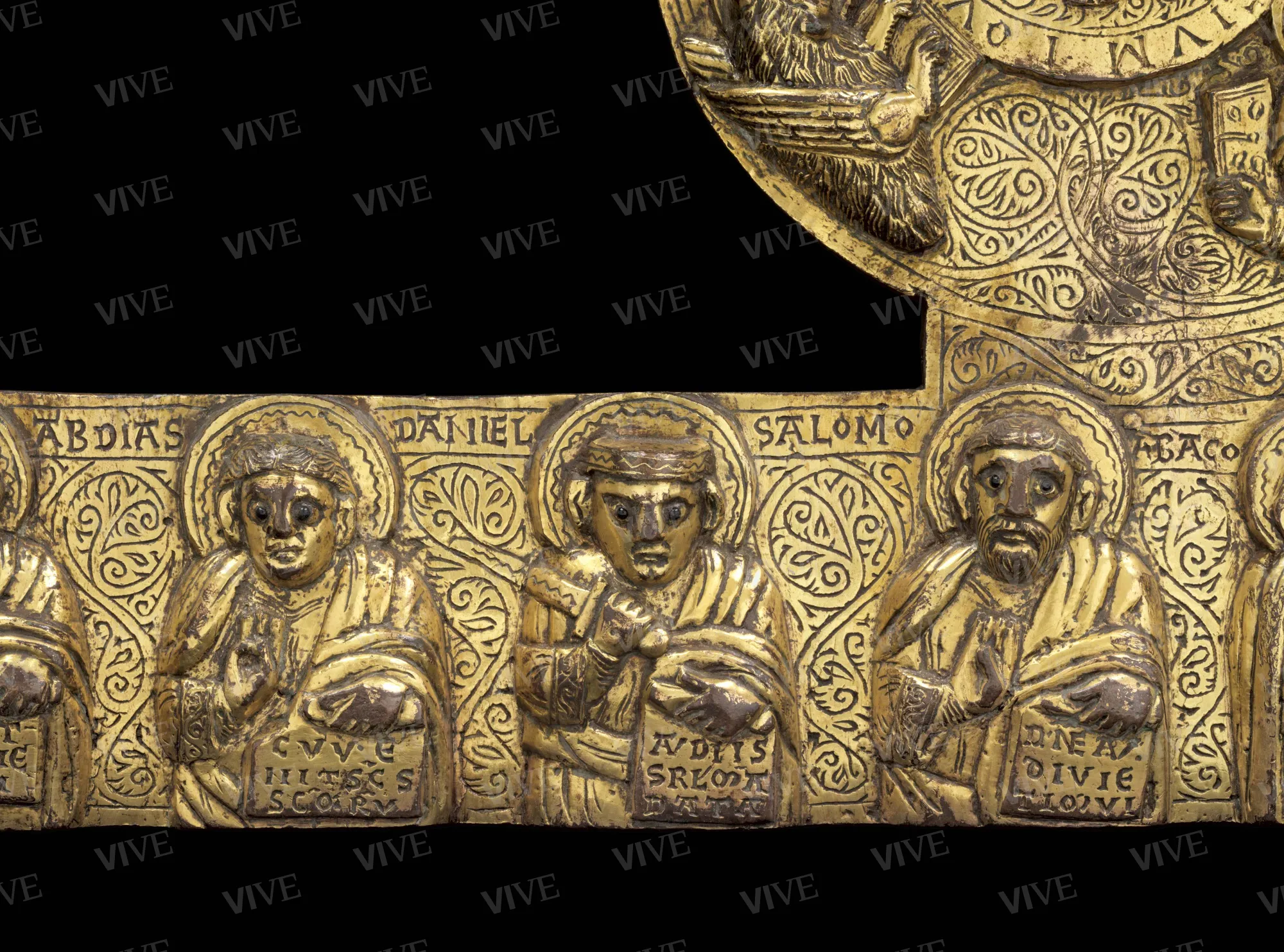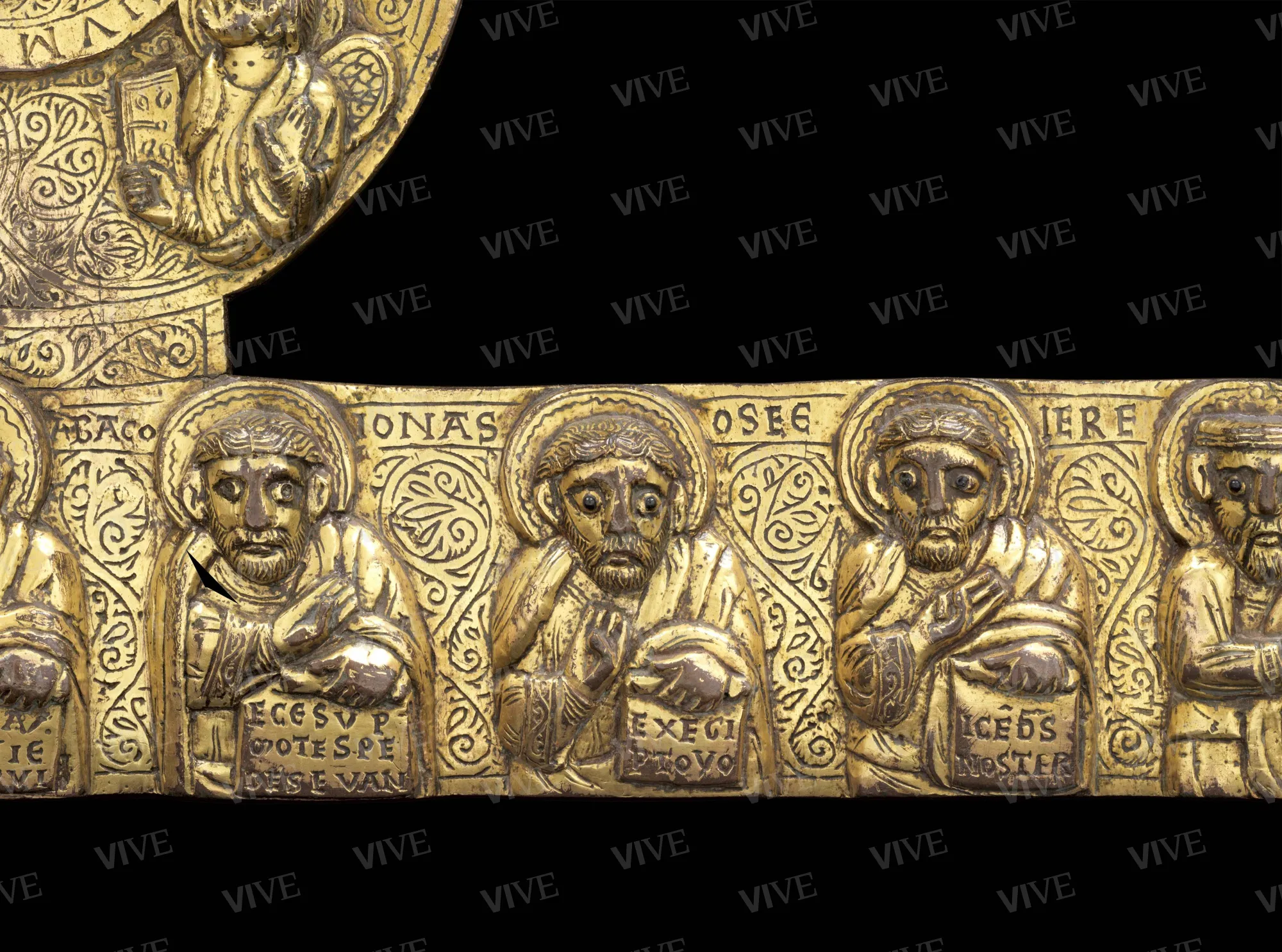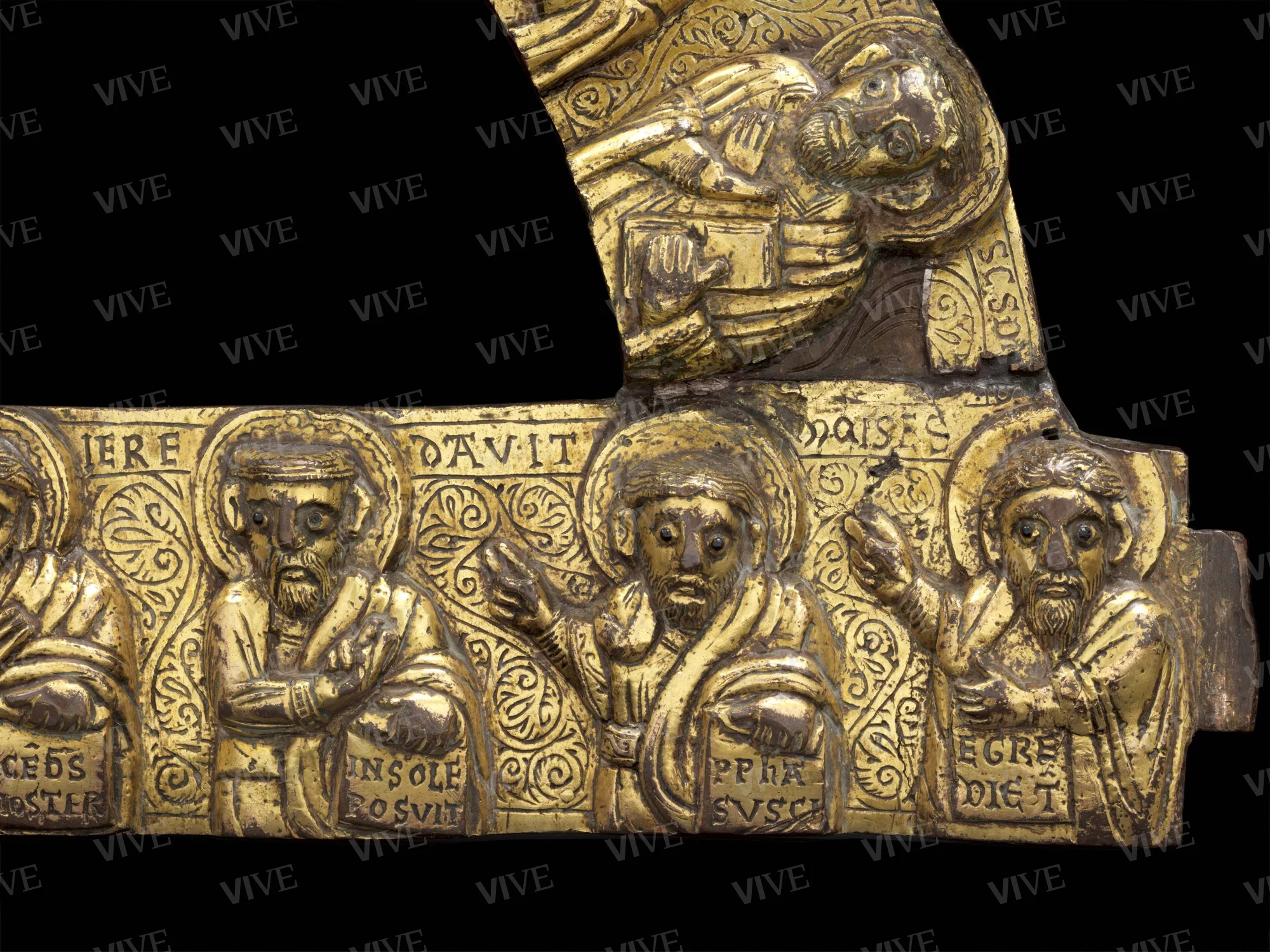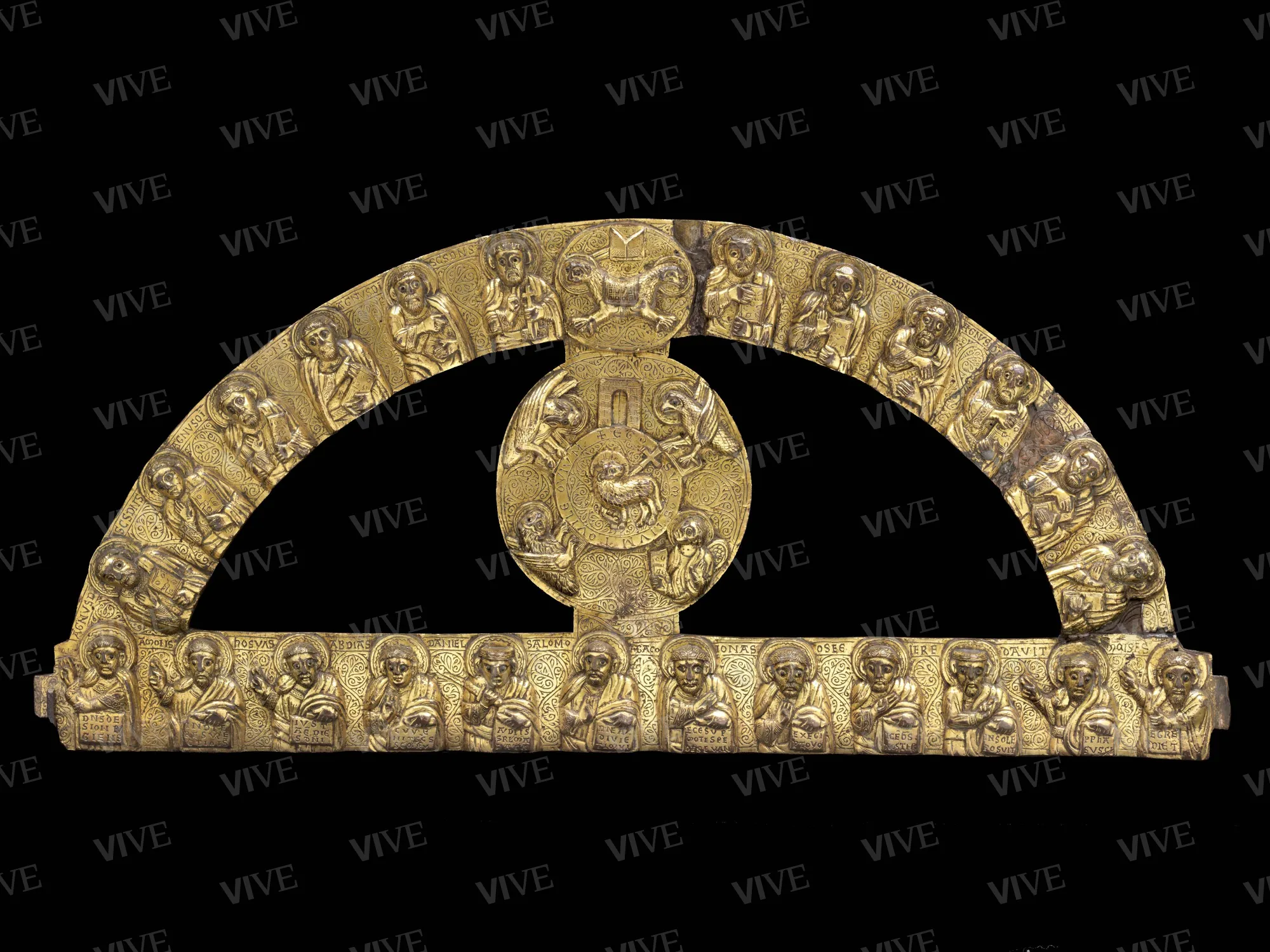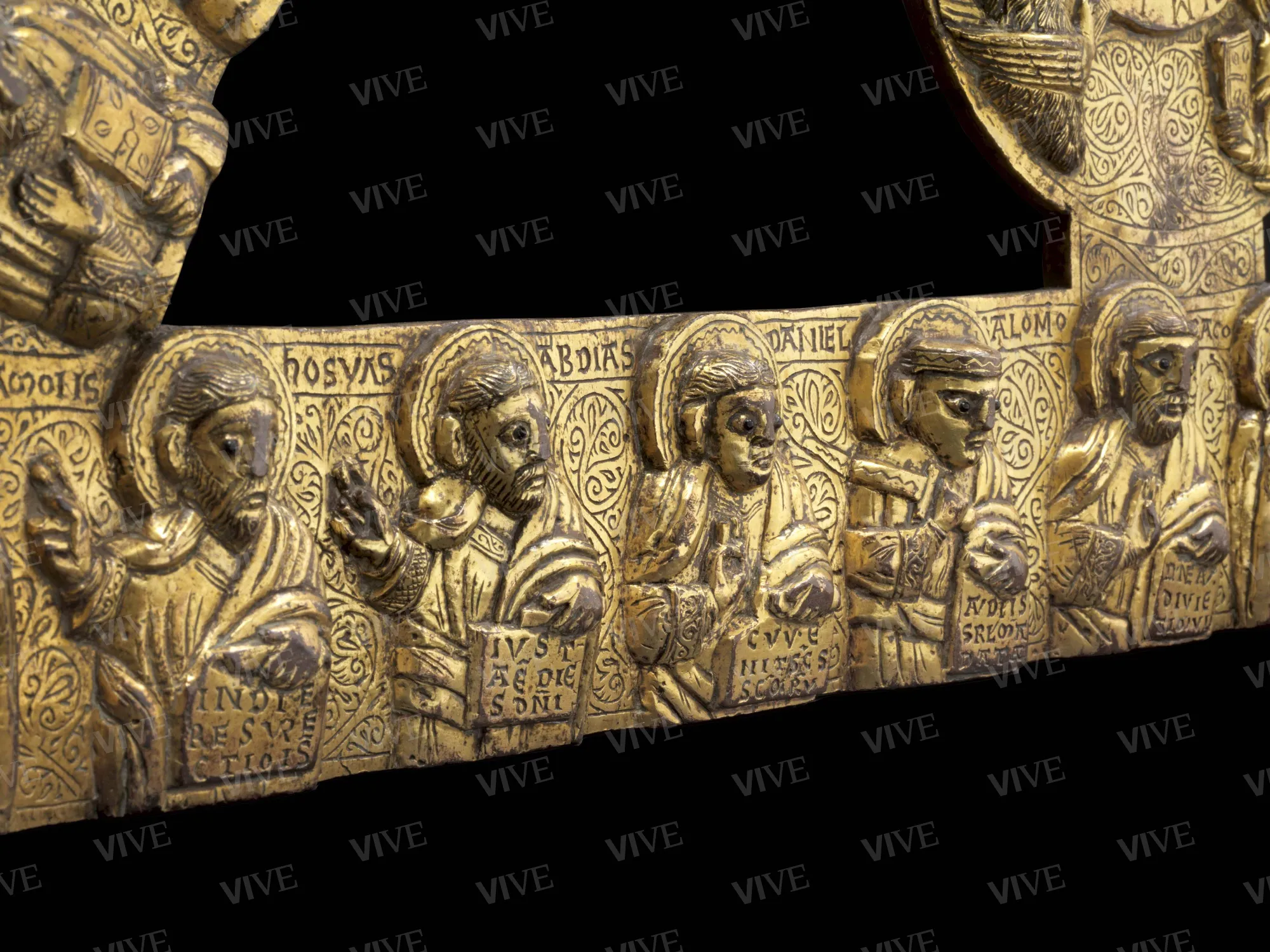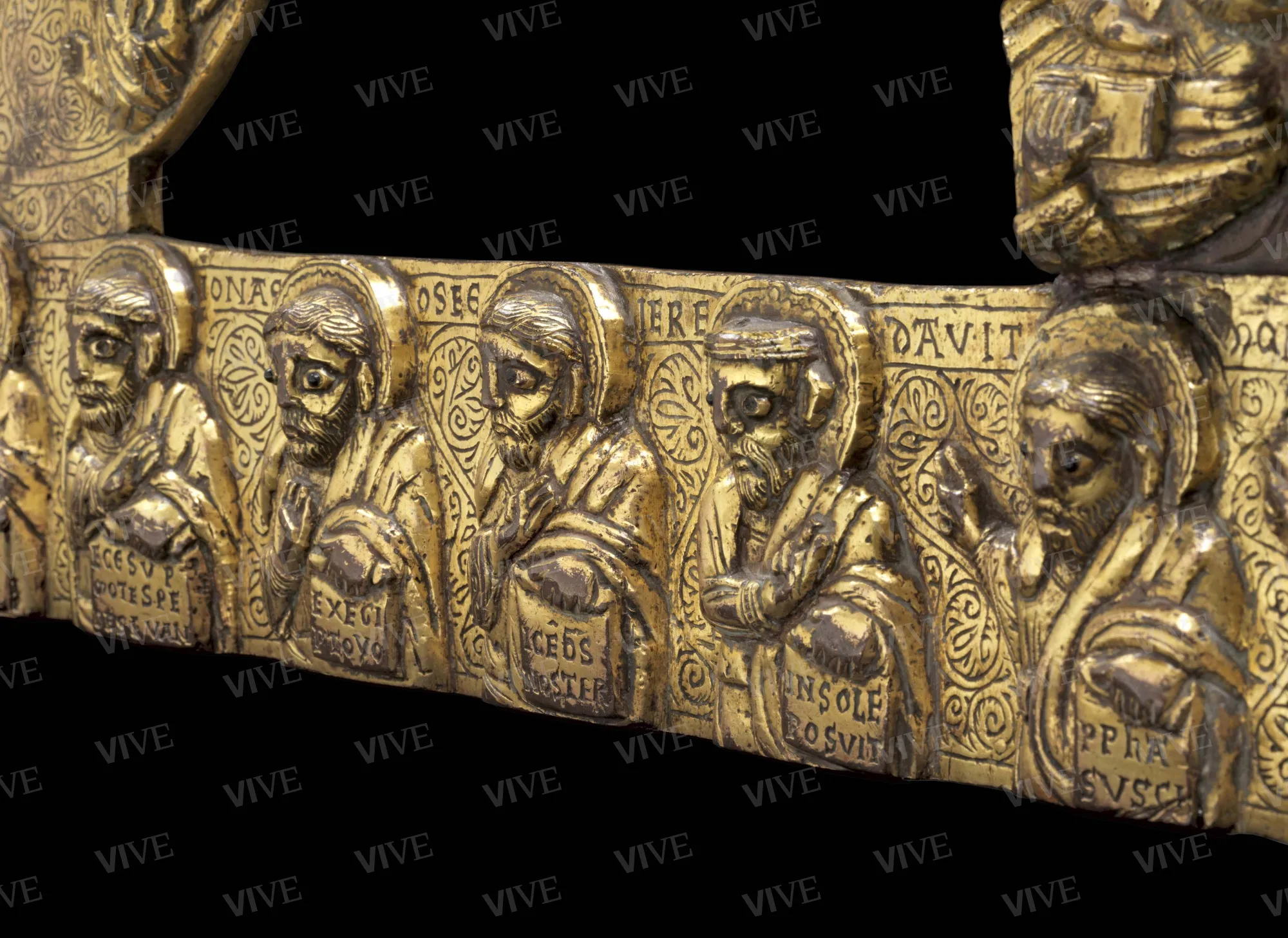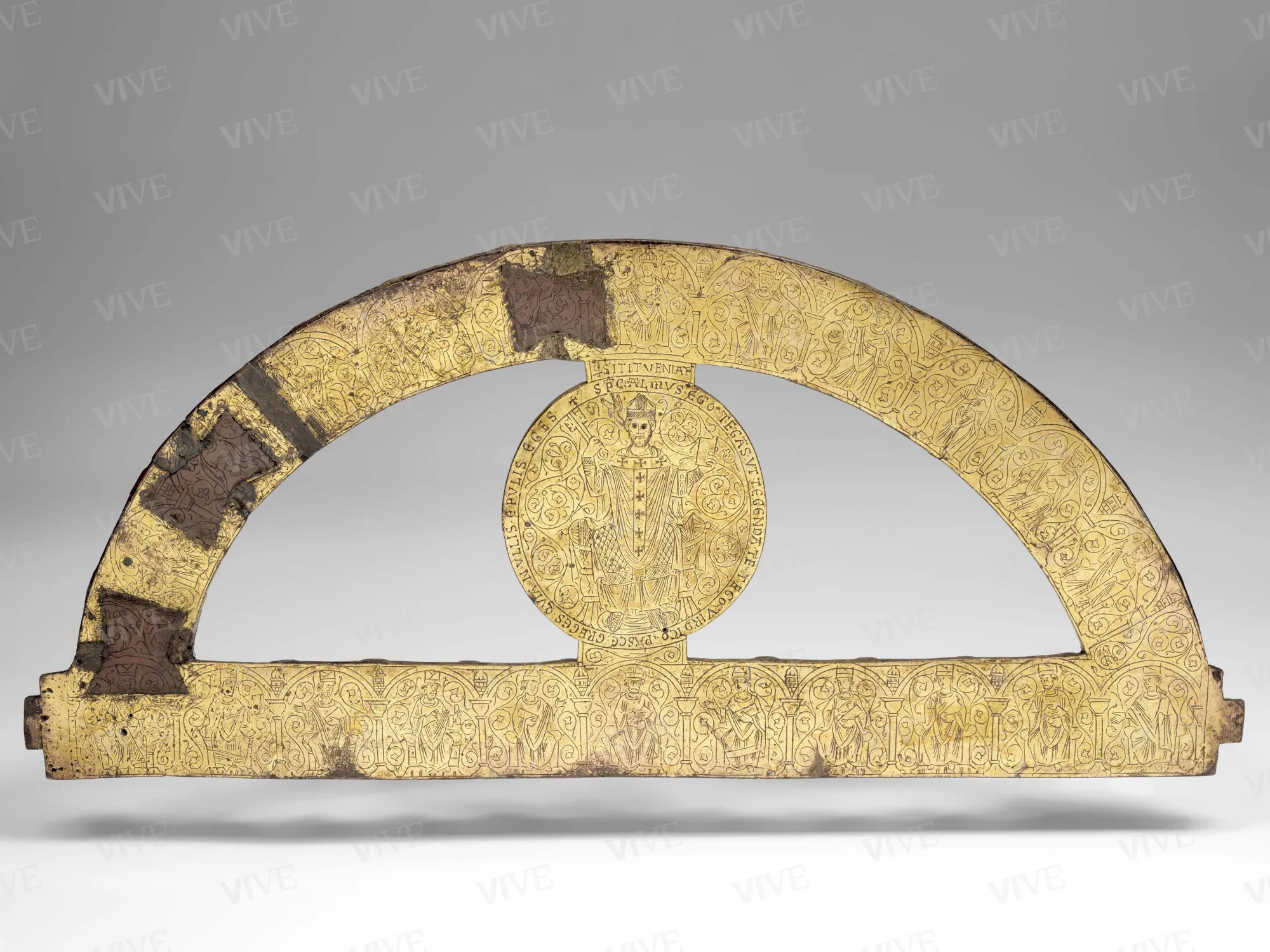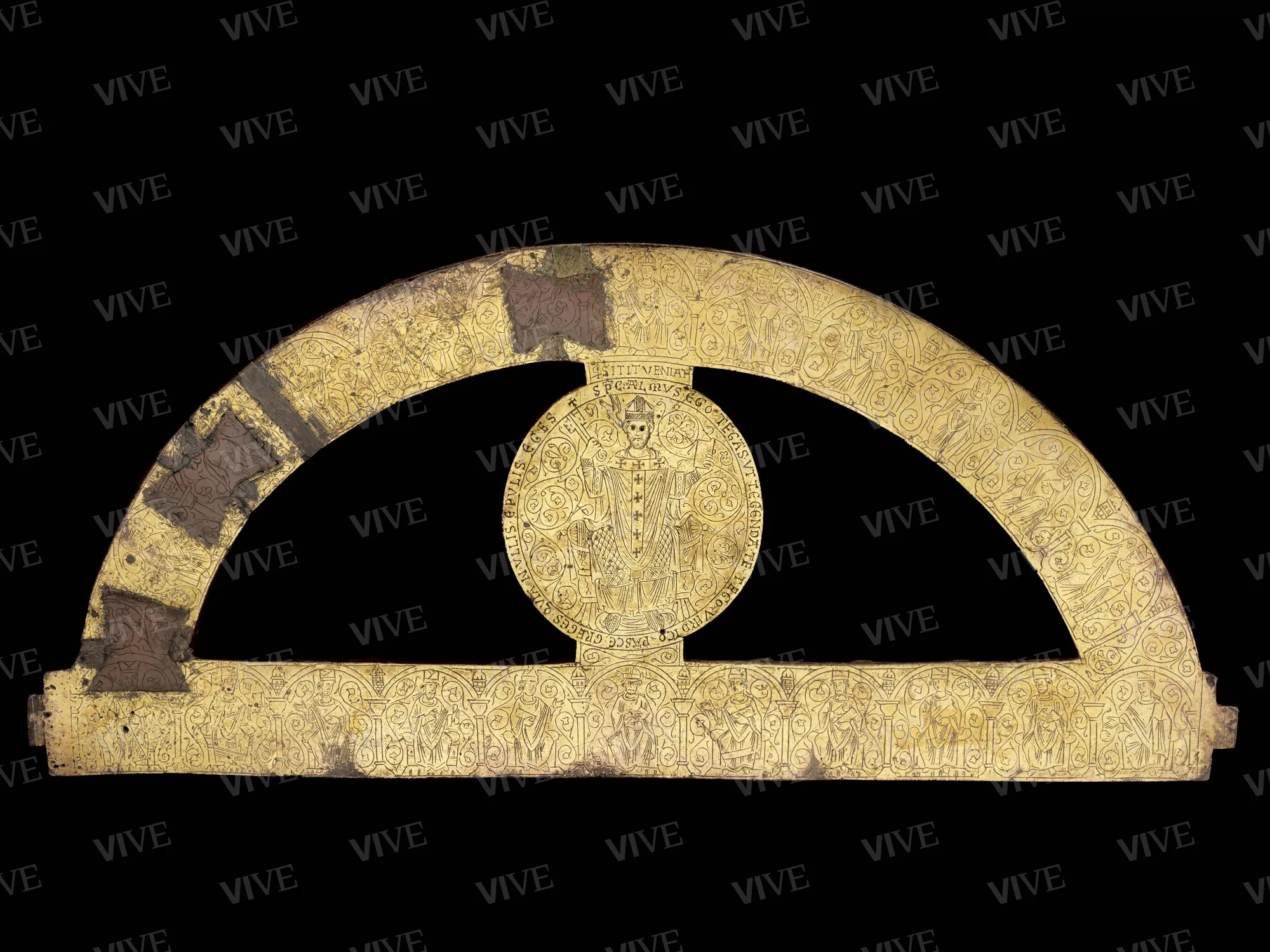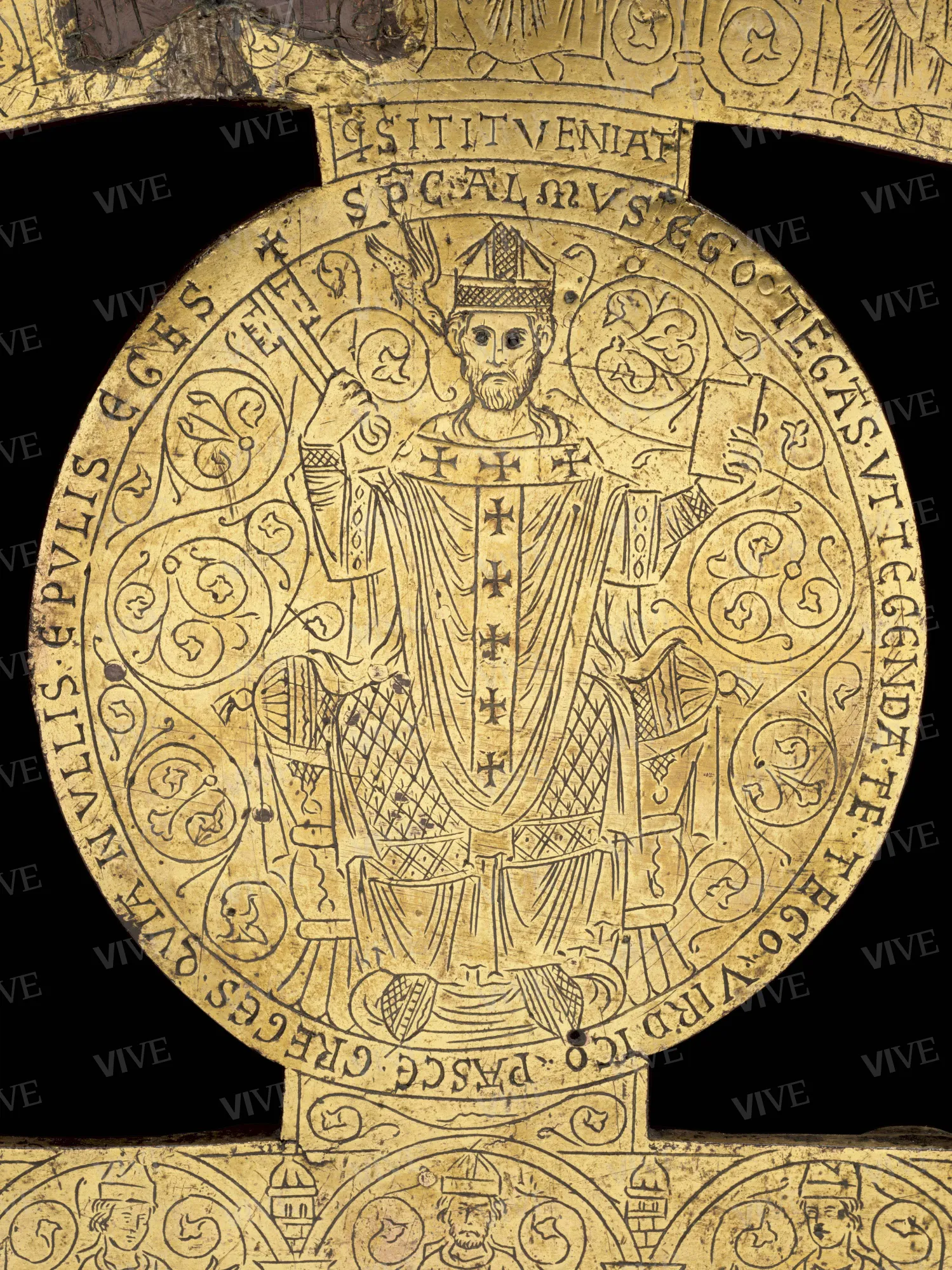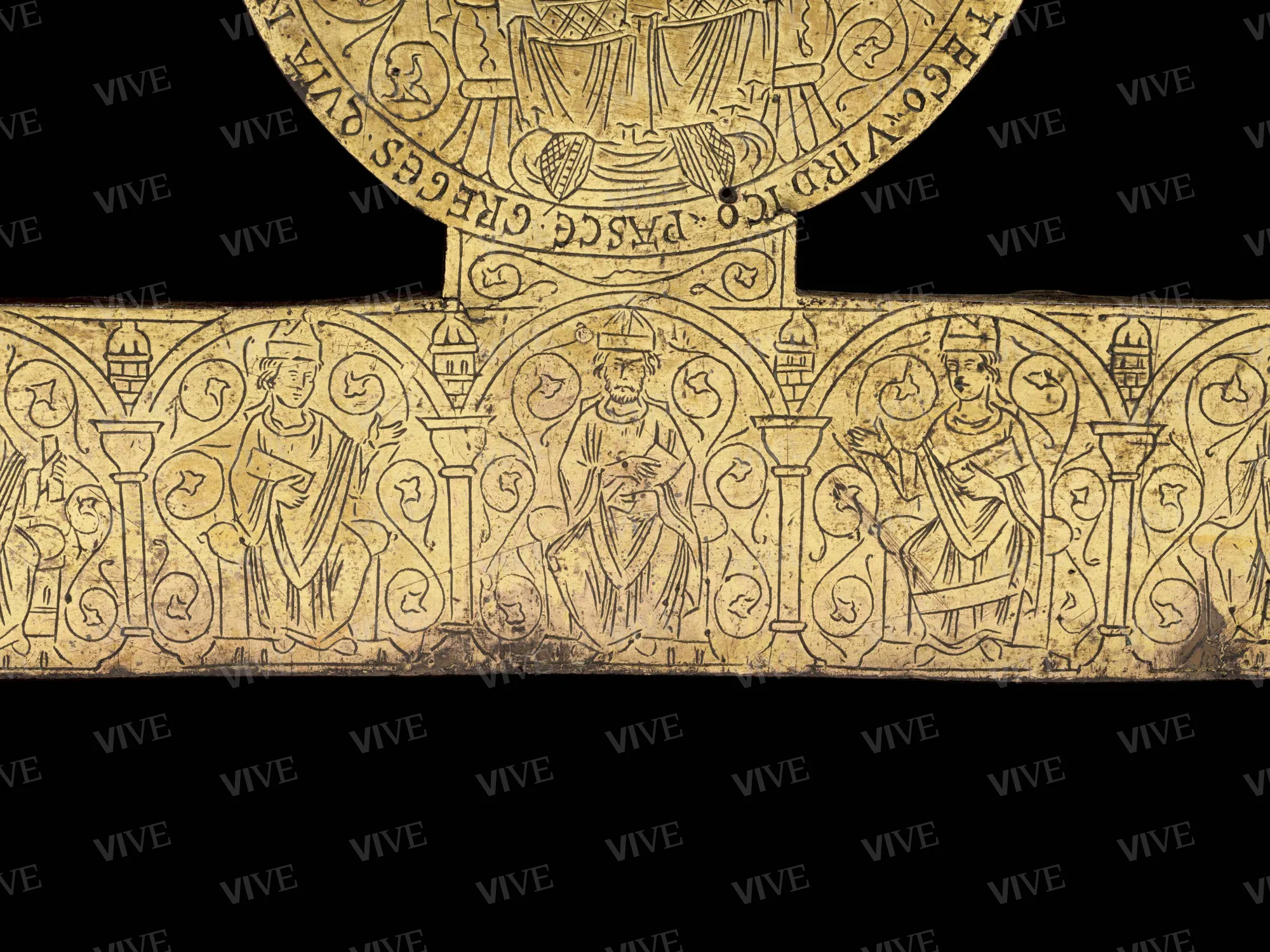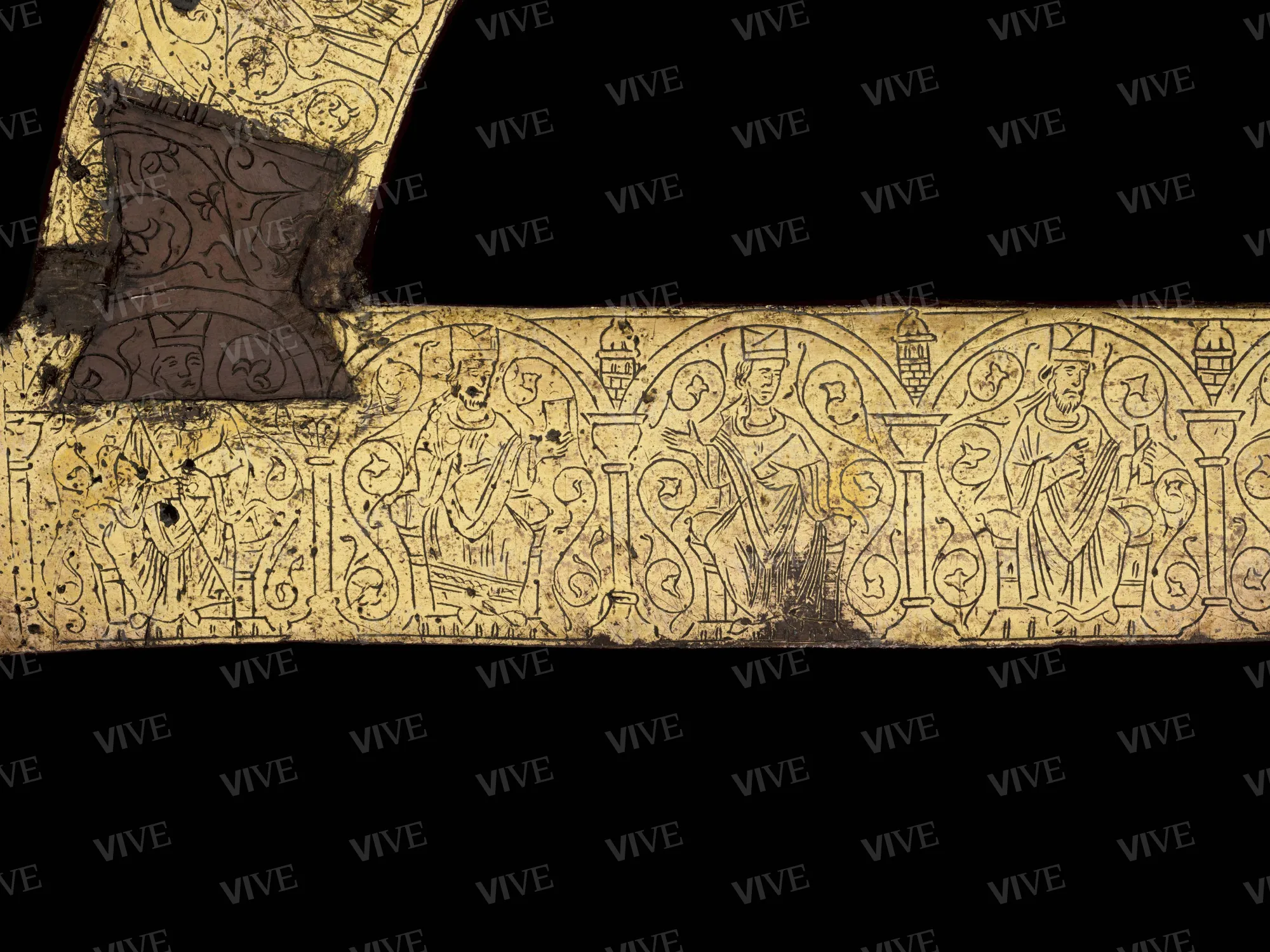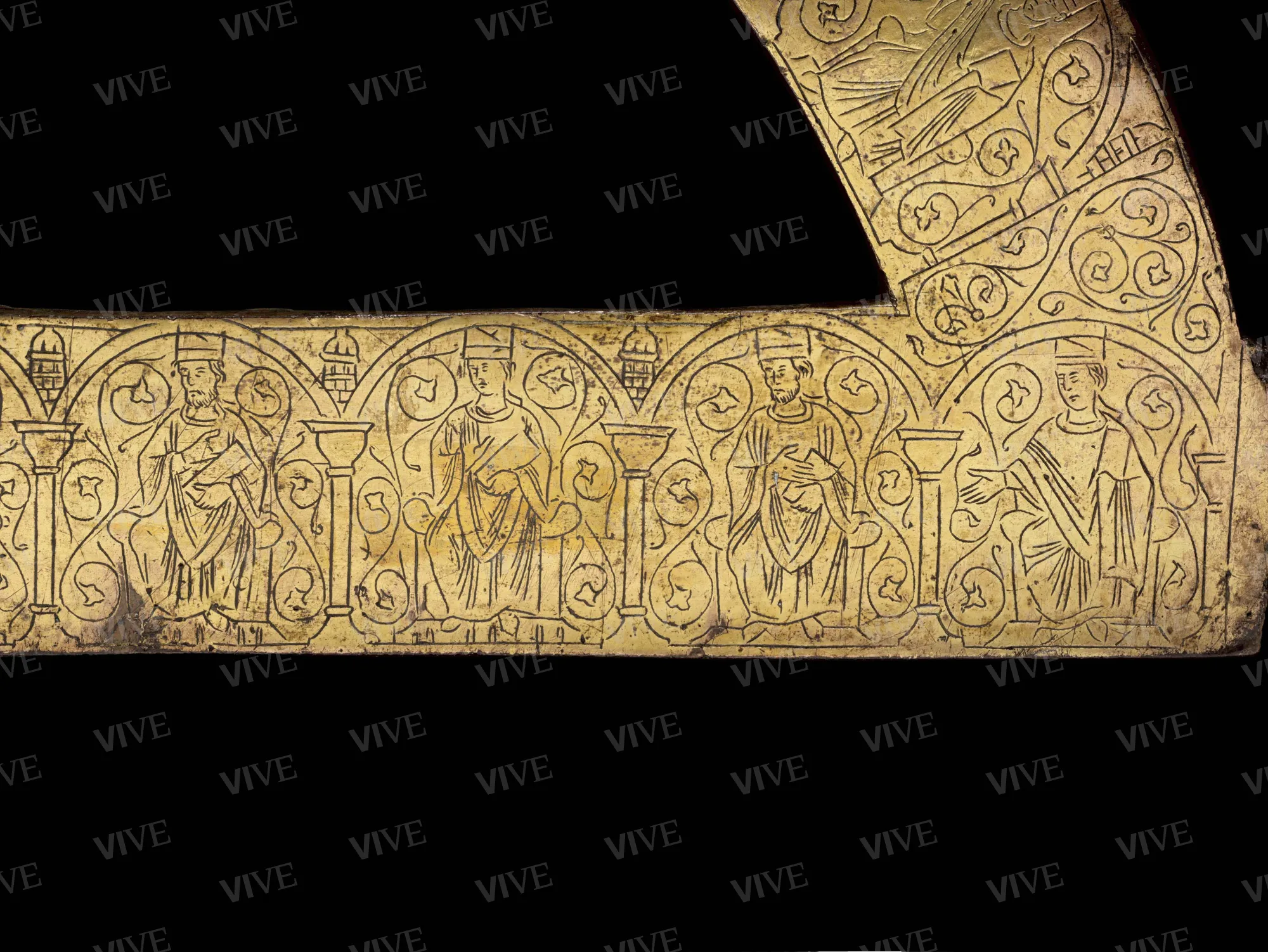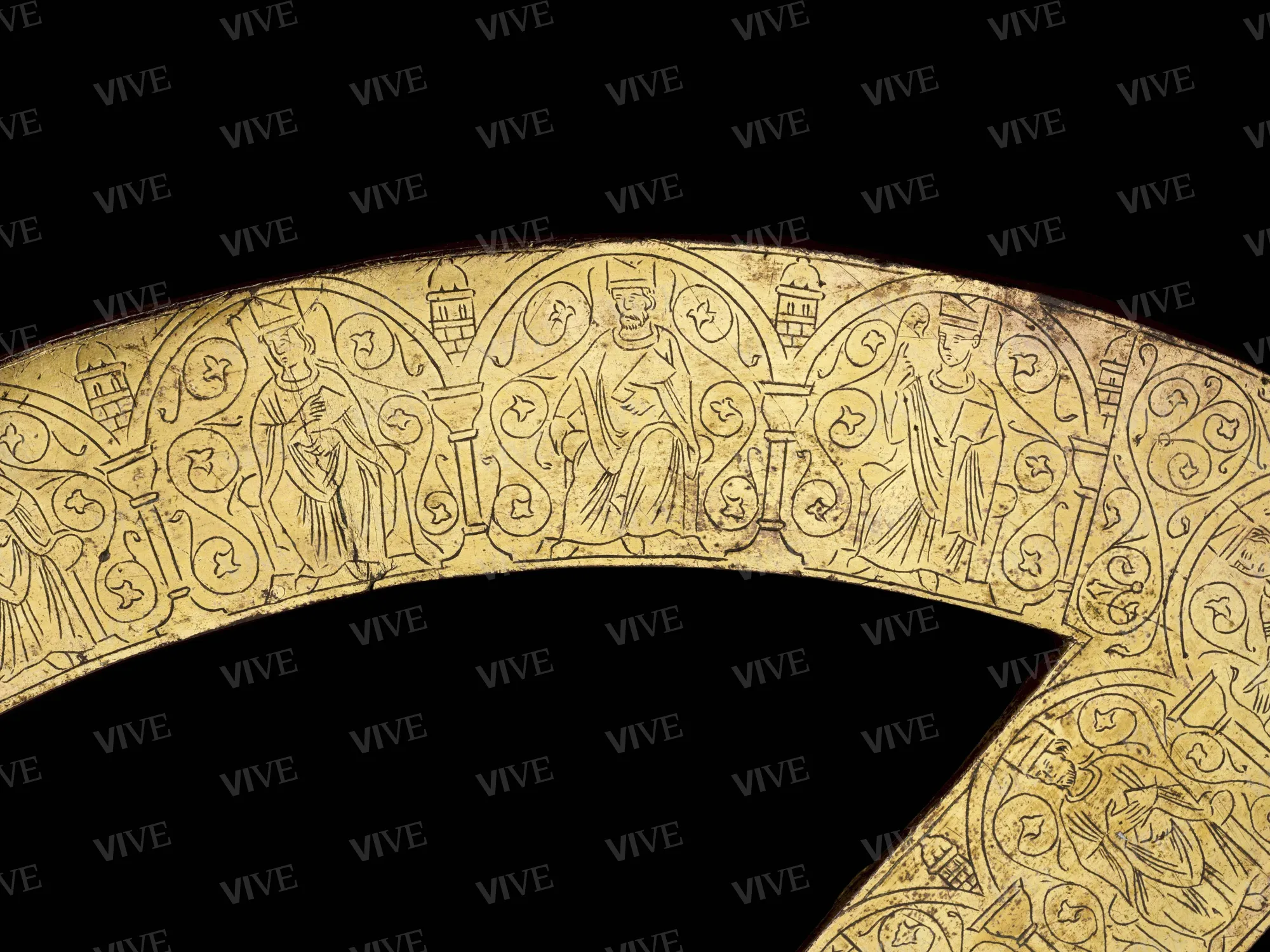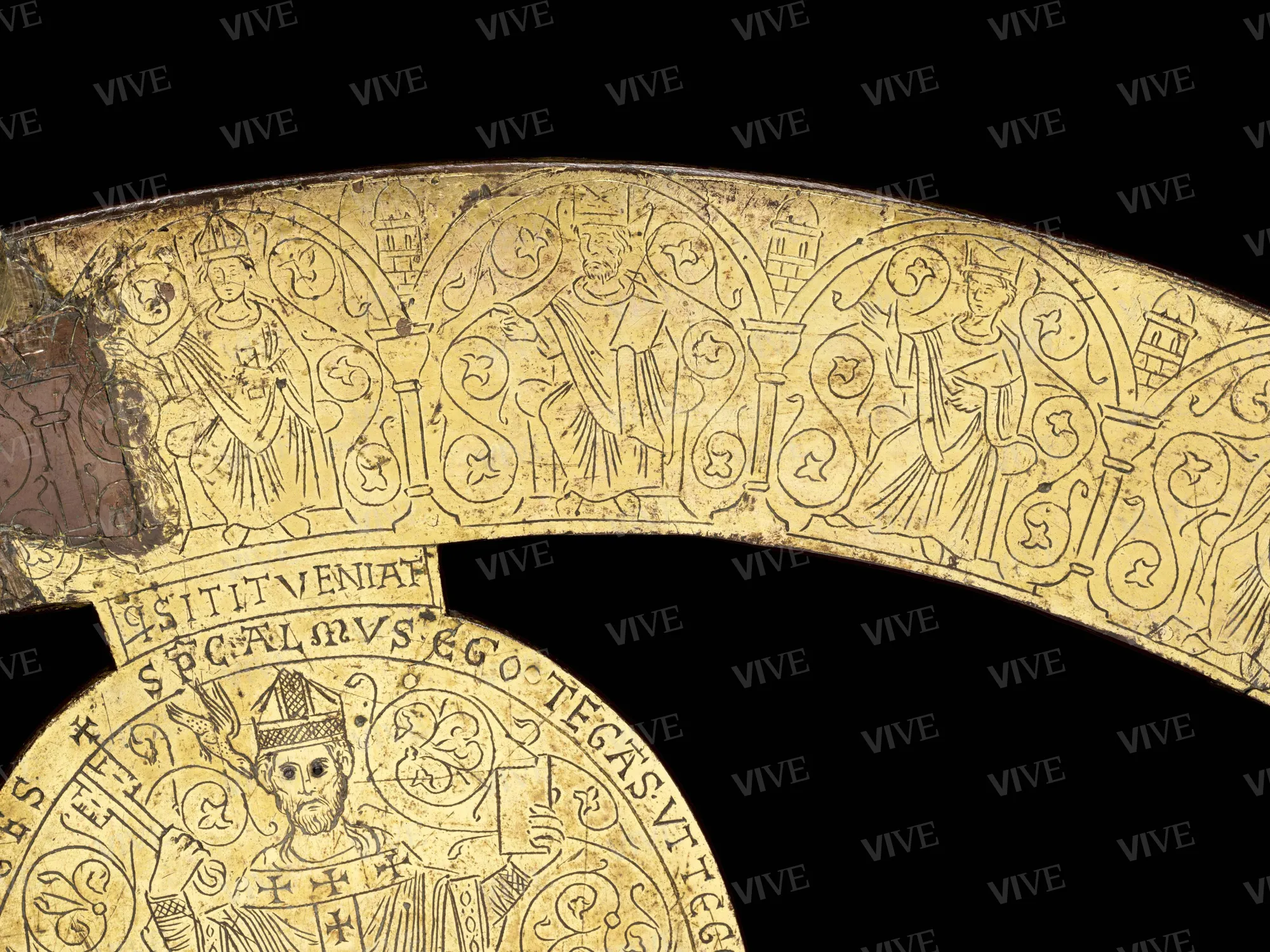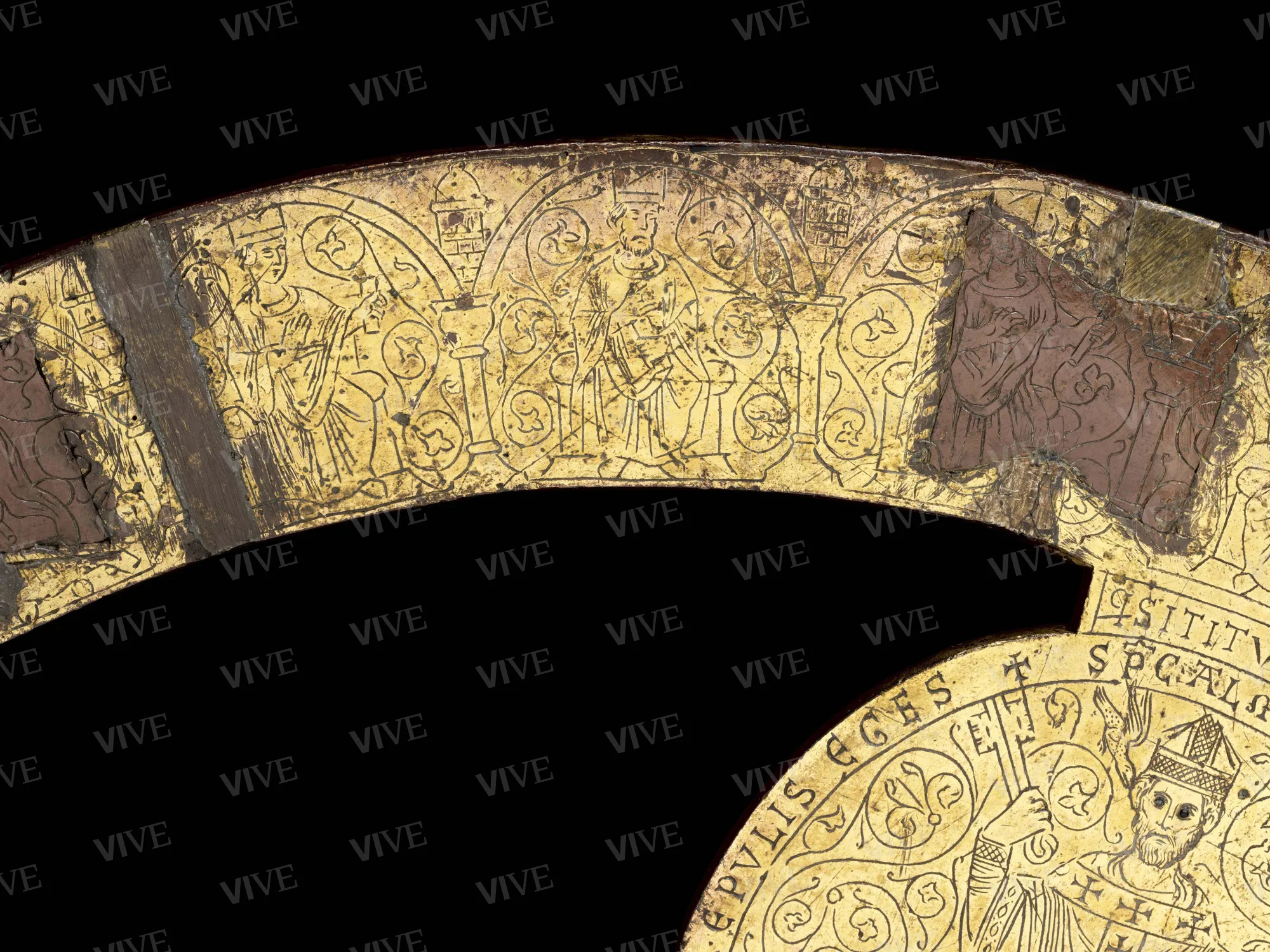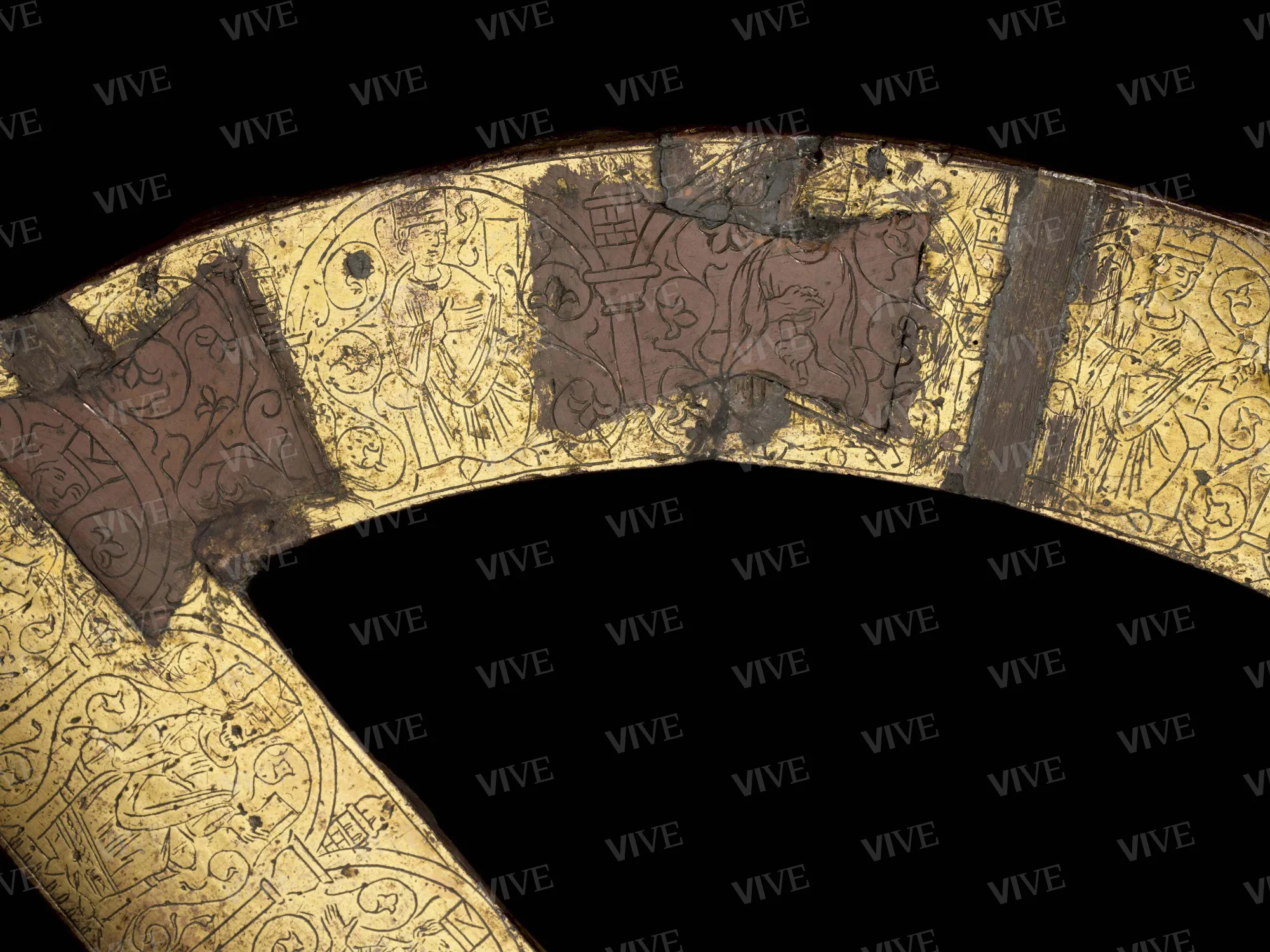Lunette
Goldsmith workshop active in Rome First decade of 13th century
The lunette of the Nicchia dei Palli is a central testimony to artistic production in Rome in the very early years of the thirteenth century, important both for its iconographic aspects and its germane role in opening up papal patronage beyond local confines in the years of Innocent III (1198–1216). The lunette develops an articulated iconographic cycle that, within the work, is intimately intertwined with a series of inscriptions, forming a unique figurative whole.
The lunette of the Nicchia dei Palli is a central testimony to artistic production in Rome in the very early years of the thirteenth century, important both for its iconographic aspects and its germane role in opening up papal patronage beyond local confines in the years of Innocent III (1198–1216). The lunette develops an articulated iconographic cycle that, within the work, is intimately intertwined with a series of inscriptions, forming a unique figurative whole.
Details of work
Catalog entry
The recto of the lunette contains twelve prophets and twelve apostles along the perimeter and the arch, respectively. Depicted as half figures, their eyes drawn with a drop of black enamel, the figures are cast and bursting with life. The prophets, shown holding a scroll in one hand and blessing with the other, are identified thanks to a series of scripts; the apostles, however, because of a lack of typical symbols, are difficult to identify with the exception of Peter, who is shown holding a set of keys. The recto of the work contains a central disk bordering on the arch and outline of the lunette and is occupied by a depiction of Christ as the lamb of God and the Gate of Salvation surrounded by a tetramorph. Above this disk, however, is a clipeus depicting an empty throne with armrests with zoomorphic extremities and a mitre. The lunette verso, on the other hand, is entirely engraved and devoid of elements in relief. The depiction is of an assize of twenty-three bishops within columned arcades, as well as the figure of a pontiff holding a mitre, a pallium, the keys of Peter, the sacred scriptures, and the Holy Spirit in the form of a dove inspiring him above the central disk. There are visible attempts at repairing the artifact, including three metal dovetail grafts (for technical aspects regarding the lunette, see Falcucci, Pantone, Variali 2023). The lunette comes from the sanctuary of Santa Maria in Mentorella, a small exurb of Guadagnolo, near Tivoli, where it is first attested in a 1581 document that describes it as a “magnam coronam ex auri calco cum prophetis et apostolis pictam et auratam pro ornamenti supra altare ponendam” (Distefano 2023, p. 102). This description—where “pictam” refers to a figured work—makes it clear that it was usually placed on the church’s high altar. It was later reproduced in a relief contained in a 1733 missive addressed to the Jesuit priest Antonio Maria Lupi (Distefano 2023, pp. 103–104).
Scholars immediately hypothesized that the work had been removed from its original context. It has sometimes been posited that it was originally part of the dossal of a bishop’s throne (Bertaux 1896, p. 406; Grisar 1897, pp. 31-32; Lipinsky 1979) or the crowning element of a reliquary casket (Rossi 1905, p. 71). The idea that it was originally part of the lavish furnishings of the Nicchia dei Palli—the area in the Vatican basilica located above the Confessio Sancti Petri reserved for the custody of the pallia—was first put forward by Marie-Madeleine Gauthier (Gauthier 1968). According to her reconstruction, it occupied the space between the gilded bronze lattice-work, which is still in the Nicchia, and a goldwork frontal. This latter, which we are familiar with thanks to a few surviving fragments held in the Museo Sacro Vaticano and even smaller fragments within the chapel, probably originally had two orders of arches and included a series of apostles and a large figure of Christ similar to the Limousin example in San Miguel de Excelsis in Navarre. According to Gauthier, this type of frontal was placed at the altar while Sible de Blauuw, following a late-sixteenth-century description by Giacomo Grimaldi, maintains it was kept behind the gate (de Blauuw pp. 655–656). The commissioner of this particular piece, probably in about 1215, the year of the Fourth Lateran Council, has been identified as Innocent III, whose name appears on the bronze lattice-work of the Nicchia (some, however, maintain it was commissioned by Innocent III—see Tomei 2023). Gauthier has been central in describing and identifying the figurative culture of the lunette, which, although very much within the context of Limousin production, nonetheless contains several interesting anomalies. Because of the style of the cast figures, the lunette was initially associated with the production of Rhine-Mosan goldsmiths and Romanesque ivories of the Rhine area (Rossi 1905; Goldschmidt 1926). According to Gauthier, however, although the presence of the ornamental vermiculated motif was a strong indication of the influence exerted on this artifact by Limoges artisans, the style of the representations brought out a local, Tuscan–Pisan component, due to the culture of the clients (Gauthier 1958, p. 365). When he returned to this issue a few years later and to the Rhine area references of the first commentators, Gauthier reformulated his initial proposal and posited that the work was undertaken in a workshop or by an artisan trained somewhere within the Empire but operating in close contact with Limousin artisans. These two craftspeople must certainly have collaborated in Rome, where Limousin goldsmiths were working on the enamel figures of the frontal. The latter would have contributed to the lunette, contributing in areas considered to be their specialties—that is, the figures and engraved ornamentation or the eyes of the prophets and apostles filled in black enamel (Gauthier 1972, p. 286). This hypothesis is currently the only one that would explain some of the peculiar elements of the lunette. The debate on the work has also touched on the passages of the inscription, whose interpretation has oscillated in the iconographic reading of certain figures, especially the inscription surrounding the depiction of the pontiff in the central disk of the verso, which opens with the nexus “SPC.” According to Giuseppe Cascioli, this should be read as “SPG,” or “SANCTUS PONTIFEX GREGORIUS,” thus identifying the figure as Gregory I who, as Julian Gardner has also more recently pointed out, according to the Liber Pontificalis account had actually sponsored a reworking of the the area of Saint Peter’s tomb (Cascioli 1898, pp. 16–17; Gardner 2013, p. 159). According to Gauthier, however, the nexus would have indicated “SPIRITUS CONSILII” or “CONCILII,” and the pope would therefore be Innocent III (Gauthier 1972, p. 285). Indeed, Innocent III revised the ceremonial of the handing over of pallia to new metropolitans, a rite that was celebrated in the very Nicchia from which it takes its name (Klein 2023). Antonio Iacobini, however, maintains that the area reworked was in some way linked to another project at Saint Peter’s Basilica, namely the large mosaic in the apse that also featured a representation of the pontiff himself. The reading of the mosaic and the lunette, therefore, would reveal a common iconographic matrix convincingly centered on the concept of papal auctoritas, which, especially in the case of the lunette, insisted on episcopal investiture (Iacobini 1989, p. 129). In the same inscription, moreover, the verb “tegere” in its meaning of “to clothe authority” would constitute further proof that the lunette was intended for the Nicchia dei Palli (Vitali 1980, pp. 170–171). In this sense, the fact that the bishops engraved on the verso of the lunette were intentionally depicted without a pallium, as noted by Iacobini, could be explained by the fact that the ceremony of the handing over of the pallium granted by the pontiff took place in the Nicchia (Iacobini 1991, p. 317).
Giampaolo Distefano
Entry published on 12 February 2025
State of conservation
Good.
Inscriptions
Inscriptions on the recto:
outer limit of the arch, repeated: “AGNVS DEI SANCTVS DOMINVS”;
around the Agnus Dei: “EGO SVM OSTIVM I(n) OVILE OVIVM”;
At the base, from left to right:
in the book held forth by the prophet: “AMOIIS,” “D(omi)N(u)S DE/ SION RV/GIENS”;
in the book held forth by the prophet: “HOSVAS,” “IN DIE/ RESVRE/CTIO(n)IS”;
in the book held forth by the prophet: “ABDIAS,” “IVST/A E(st) DIE/S D(omi)NI”;
in the book held forth by the prophet: “DANIEL,” “CV(m) VE/NIT S(an)C(tu)S/ S(an)C(t)ORV(m)”;
in the book held forth by the prophet: “SALOMO,” “AVDI IS/SR(ahe)L’ MA(n)/DATA”;
in the book held forth by the prophet: “ABACO,” “D(omi)NE AV/DIVI E(t)/ TIMVI”;
in the book held forth by the prophet: “IONAS,” “EC(c)E SVP(er)/ MO(n)TES PE/DES EVAN(gelizantis)”;
in the book held forth by the prophet: “OSEE,” “EX EGI/PTO VO(cables)”;
in the book held forth by the prophet: “IERE,” “IC(c)E D(ominu)S/ NOSTER”;
in the book held forth by the prophet: “DAVIT,” “IN SOLE/ POSVIT”;
“MOISES,” “P(ro)PH(et)A(m)/ SVSCI(tabit)”;
in the book held forth by the prophet: “EGRE/DIET(ur)”.
Inscriptions on verso:
central disk, verso“SP(iritu)C ALMVS EGO TEGAS VT TEGENDA.TE. TEGO. VIR DICO PASCE GREGES QVIA NVLLIS EPVLIS EGES +”;
above the central disc“QVI SITIT VENIAT".
Provenance
Capranica Prenistina, hamlet of Guadagnolo (Rome), Shrine of Santa Maria in Mentorella (or Vulturella).
Exhibition history
Orvieto, Palazzo dei Papi, Mostra d’arte sacra antica, September 1896, no. 3;
Turin, Esposizione d’Arte Sacra antica e moderna, 1898, no. 246;
The Hague, Gemeentemuseum, L’Italia splendida. Pronkjuwelen der Italiaanse sierkunst, August 29–October 31 1956, no. 1;
Barcelona, Palais national de Montjouic and Santiago de Compostela, cathedral, L’art roman, July–October 1961, no. 395;
Rome, Palazzo delle Esposizioni, Tesori d’arte sacra di Roma e del Lazio dal medioevo all’Ottocento, November–December 1975, no. 17;
Rome, Museo Nazionale di Palazzo di Venezia, Romei e Giubilei. Il Pellegrinaggio medievale a San Pietro (350–1350), October 29 1999–February 26 2000, no. 262.
References
Bertaux Émile, L’esposizione di Orvieto e la storia delle arti, in «Archivio Storico dell’arte», II, 1896, pp. 405-426;
Grisar Hartmann, Note archeologiche sulla mostra di arte sacra antica a Orvieto, in «Nuovo bollettino di archeologia cristiana», III, 1897, 1-2, pp. 5-44;
Cascioli Giuseppe, Memorie popolari del Santuario di N.S. della Mentorella in diocesi di Tivoli diretta ad ottenere l’incoronazione della solenne taumaturga immagine, Roma 1898;
Rossi Attilio, Santa Maria in Vulturella. Ricerche di storia ed arte, Roma 1905;
Gauthier Marie-Madeleine, Les décors vermiculés dans les émaux champlevés limousins et méridionaux, in «Cahiers de civilisation médiéval», 1, 1958, 3, pp. 349-369;
Gauthier Marie-Madeleine, Observations préliminaires sur les restes d’un revêtement d’émail champlevé fait pour la Confession de Saint Pierre à Rome, in «Bulletin de la Société archéologique et historique du Limousin», XCI, 1964, pp. 43-70;
Gauthier Marie-Madeleine, La clôture émaillée de la Confession de Saint Pierre au Vatican, lors du Concile de Latran IV, 1215, in Synthronon. Art et archéologie de la fin de l'Antiquité et du Moyen Age. Recueil d'études, Paris 1968, pp. 237-246;
Gauthier Marie-Madeleine, L’art de l’émail champlevé en Italie à l’époque primitive du gothique, in Salmi Mario (a cura di), Il gotico a Pistoia nei suoi rapporti con l’arte gotica italiana, Atti del secondo convegno internazionale di studi (Pistoia, 24-30 aprile 1966), Roma 1972, pp. 271-293;
Lipinsky Angelo, Il tesoro del santuario di S. Maria in Vulturella, in «Atti e memorie della Società tiburtina di storia e d’arte», LI, 1979, pp. 97-145;
Vitali Federica, Il frontale della Confessione vaticana, in Romanini Angiola Maria (a cura di), Federico II e l’arte del Duecento italiano. Atti della III settimana di studi di Storia dell’arte medievale dell’Università di Roma (1978), Galatina 1980, II, pp. 159-172;
de Blaauw Sible, Cultus et decor. Liturgia e architettura nella Roma tardoantica e medievale, Città del Vaticano 1994, pp. 655-656;
Iacobini Antonio, Il mosaico absidale di San Pietro in Vaticano, in Andaloro Maria, Ghidoli Alessandra, Iacobini Antonio, Romano Serena, Tomei Alessandro (a cura di), Fragmenta picta. Affreschi e mosaici staccati del Medioevo romano, catalogo della mostra (Roma, Castel Sant’Angelo, 15 dicembre 1989-18 febbraio 1990), Roma 1989, pp. 119-129;
Iacobini Antonio, La pittura e le arti suntuarie: da Innocenzo III a Innocenzo IV (1198-1254), in Romanini Angiola Maria (a cura di), Roma nel Duecento. L'arte nella città dei papi da Innocenzo III a Bonifacio VIII, Torino 1991, pp. 237-319;
Gardner Julian, The Roman Crucible. The Artistic Patronage of the Papacy 1198-1304, München 2013.
Distefano Giampaolo, “Un non so che d’ornamento di bronzo”. La lunetta di Palazzo Venezia tra stili internazionali e contesti locali, in Tomei Alessandro (a cura di), Bronzo e oro. Roma, Papa Innocenzo III: racconto di un capolavoro, catalogo della mostra (Roma, Complesso del Vittoriano, 1 giugno-24 settembre 2023), Milano 2023, pp. 100-115;
Falcucci Claudio, Pantone Luca, Variali Marta, La lunetta della Nicchia dei Palli: dagli studi tecnici all’intervento di restauro, in Tomei Alessandro (a cura di), Bronzo e oro. Roma, Papa Innocenzo III: racconto di un capolavoro, catalogo della mostra (Roma, Complesso del Vittoriano, 1 giugno-24 settembre 2023), Milano 2023, pp. 116-127;
Klein Almuth, La cripta di San Pietro: funzione liturgica e usi nell’antica basilica vaticana, in Tomei Alessandro (a cura di), Oro e bronzo. Roma, Papa Innocenzo III: racconto di un capolavoro, catalogo della mostra (Roma, Complesso del Vittoriano, 1 giugno-24 settembre 2023), Milano 2023, pp. 135-147;
Tomei Alessandro, Innocenzo III e Roma, in Tomei Alessandro (a cura di), Bronzo e oro. Roma, papa Innocenzo III: racconto di un capolavoro, catalogo della mostra (Roma, Complesso del Vittoriano, 1 giugno-24 settembre 2023), Milano 2023, pp. 25-43.

